ENVIRONMENTAL PROTECTION COMMITTEE MINUTES - MARCH 14, 2018
MICHAEL E. PLOCHOCKI, CHAIRMAN
MEMBERS PRESENT: Mrs. Tassone, Ms. Cody, Mr. Burtis, Dr. Chase
ALSO ATTENDING: See attached list
Chair Plochocki called the meeting to order at 9:10 a.m. A motion was made by Mrs. Tassone, seconded by Ms. Cody, to waive the reading of the proceedings from the previous committee. MOTION CARRIED. A motion was made by Mrs. Tassone, seconded by Mr. Burtis, to approve the minutes from the previous committee. MOTION CARRIED.
1. LAKE IMPROVEMENT: Tom Rhoads, P.E., Commissioner
a. ACJ Update
Chairman Plochocki said that Commissioner Rhoads was more than anxious to present this report in January. Normally, aside from Ways and Means, we are probably the busiest committee; constantly meeting, having legislation and things to discuss. That being said, the last couple of months have been quiet so he put this off. Even though this is the only official item on the agenda, he did not want to wait until next month as we would be giving two reports at the same meeting.
Mr. Rhoads:
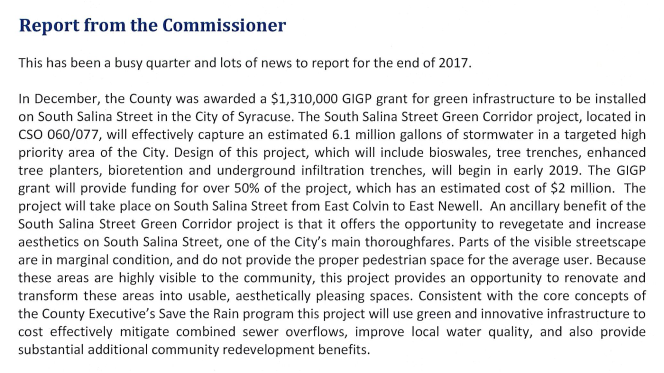
In answer to Chair Plochocki, Mr. Rhoads confirmed that this money was accepted last month. Chairman Plochocki said that he wanted everyone to be clear that the legislature approved this last month and there are not two projects on South Salina Street.

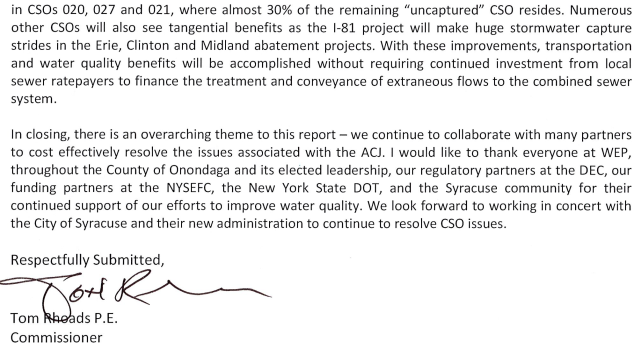
-
Look for triple bottom line in everything we do, benefit to the people, environment and wallet
-
Meadowbrook–Limestone WWTP drowning under extraneous flow, often receive flows 10x the permit limit, caused by most municipalities within that service area not maintaining their sewers, includes several towns, villages and Meadowbrook section of the city; wastewater grade D nationwide, have same issues here, sewer miles the same as roads, rebuild roads every 20 years, question whether sewers are getting rebuilt or seeing that same investment.
Chairman Plochocki said that this a problem for all the obvious reasons. To be precise about a few things:
1) Portions of the network of wastewater pipes under the City are owned by the County, a patchwork quilt of pipes with a good portion owned by each, if the City has I&I issues it is a problem for us as the systems are totally intertwined; sometimes the case is the same in the suburbs, i.e. Marcellus has its own wastewater system, I&I problems are Marcellus’ issue, the village and other users have to pay for it, in the case of the City, it is also a problem for us
2) Met with Mayor Walsh and talked with several people at City Hall, started beginning of long-term discussion on this
For the record, Chairman Plochocki said, “I found the mayor and his staff to be incredibly receptive in wanting to talk about not just the problem, but to have a serious talk about beginning to move down the long road towards solutions.”
-
City has 312 miles of sewers, ¾ come to Metro, ¼ go to Meadowbrook-Limestone WWTP, about 1,500 miles of city and suburban sewers, about 1,200 miles of suburban, County owns about 600 miles; much work being done, invested almost $8.9M in town and village sewers through the SGIP, in this case $250,000 is going to the City
-
Unfortunately we are making the lion’s share of investment in locally owned sewers, showing them the way and giving them the tools, providing piggyback contracts but can’t do all the investment and can’t have WWTP’s treating 9-10x’s what we need to treat or even 30x’s what is anticipated, i.e. wet weather thaw; have plants not meeting permit, not taken lightly by the DEC
-
Cost for road reconstruction work far less, 1/3 the typical Save the Rain cost, they are the most cost effective projects and are done in partnership with the City, typically work together on one cut/dig theory – National Grid replaces gas lines, WEP puts in trenches and then the City rebuilds the roadways, harmony takes much effort but we are making tremendous strides in how stormwater is captured, cost effectively preventing CSO’s
-
Working at neighborhood level, do outreach, get neighbors involved, rather than tearing down the neighborhood to build a regional treatment plant we are doing neighborhood scaled projects and make things right when we leave
-
NYSDOT agreement to capture I-81 stormwater, regardless of design, will help achieve lasting water quality benefits and will be part of federally funded state project; CSO won’t be resolved until I-81 is rebuilt, need state to understand this won’t be resolved immediately with local dollars as we have a commitment from DOT that this will be resolved by them as part of their project
-
Big picture, as long as there is CSO overflow there will be impacts to water quality but we have a partnership, continue collaboration with many partners: City of Syracuse, DEC, EFC, ESD, DOT, critical for utility that has thousands of miles of sewers and serves hundreds of thousands of customers
-
Gray Projects Update: no longer doing gray projects
-
Green Projects Update: many green projects, had punch list items from 2017 green street projects, many projects in design: Roney, Comstock, McKinley, Charmouth, Elmhurst, and South Ave., gearing up for 2018, 1 small project started yesterday, much on the docket this year, project fact sheets included, working on things like public infrastructure, fire houses, parks, and many green streets
-
Green Improvement: public/private partnership, several funds approved late 2017, i.e. auto row, property owner pays portion of capital costs then owns and maintains porous pavement, another huge dollar saving opportunity and gives private partner a little investment to improve their property
-
Metro WWTP: talks about invasive species, the lake, what the biological monitoring program is and what we are doing, accomplished quite a bit in the lake, point of fact the lake is done, meeting water quality, talking about swimming in the lake; want to get away from the County paying for looking at things like Round Goby, Rudd Fish and other interesting things that are exciting science, need other partner to continue this science, no reason for Sanitary District to be looking at science, know a lot about the lake from a biological standpoint, provided ClearWaters magazine to help you understand, want to move toward new paradigm, why spend millions of dollars to study science that has nothing to do with the sanitary sewer or our contributions to the lake, shift emphasis from study and biology reports of the lake to investing in continued improvements to infrastructure
Chairman Plochocki asked how to make that happen. Mr. Rhoads answered that we continue to talk to the DEC about the appropriate opportunities to revisit as we close out the ACJ in 2018. The biology of the lake is typically measured by what comes out of an outfall; don’t think many other wastewater utilities do anything accept measure what comes out of their pipe. We do a good job of maintaining our performance at Metro. If there are other contributing factors, from other legacy or environmental conditions, they should be studied by others. Dr. Chase said that we have a great resource at ESF and she is sure they would be more than happy to do the research that we have been investing so much money in. Mr. Rhoads said that there may even be money for some of that research because of the various superfund cleanups and natural resource damage discussions around the lake. There is a pot of money set aside for those to continued study, separate and distinct from what we do. We have been the baseline for these reports for 20 years. Maybe lake monitoring should be shifted to the people who are monitoring the phases of their cleanup. We will continue to monitor everything that comes out of our pipes and the contributories.
In answer to Chairman Plochocki, Mr. Rhoads said that the ACJ Final Report is due April 1, 2019, but we are required to do reports until they say it is over. Our goal is to be bring it to a conclusion. We are spending over a million dollars to produce the Annual Report. Chairman Plochocki asked what committee members could do to help wrap-up the constant studying; would it be helpful to meet with the DEC. Mr. Rhoads said that this will be a good and important public discussion. It benefits all of us to ask the pubic if they would rather see the million dollars per year spent on continued improvement projects that deliver asset improvement, or green infrastructure, in the areas where there is ongoing work or spent on reports, reports, reports. We already know a lot about the remarkable recovery of the lake. Now other aspects of that lake recovery are related to legacy industrial cleanups. Why should our WWTP be the laboring oar in those measurements when there are other entities and formal parts of that environmental process with the EPA and DEC on legacy cleanups? Those legacy cleanups could find partners to carry on the good work. All of you are leaders in your community and touch base with other elected officials. Your support in letting the public know what a great job you have been part of and the contributions to cleaning up the lake is helpful in that dialogue. We still have things to do and know that until I-81 things are fixed there will be some combined sewer overflows, which we know will be abated. We are turning a corner and now is the time to talk about change and investing right.
Mr. Burtis asked if there was any idea what the savings would be once the I-81 issue was resolved. Mr. Rhoads answered that almost 30% of the remaining uncaptured CSO resides in active sewersheds that will be significantly impacted in a positive way by I-81, ISO 020, 021, 027 and many more. We will also be reducing the amount of treated stormwater at Metro, which provides capacity for future industrial growth. Thanks to the County Executive, we stayed after that theme for a couple of years. She brought together higher level discussions with the state DOT and they are making commitments that our legacy stormwater issue associated with the highway build has to change.
Dr. Chase asked if any huge projects would be forth coming; as the Chairman said, we probably spend more money than any of the other committees. Mr. Rhoads answered that it was a good thing. Dr. Chase said they are defiantly needed. Chairman Plochocki said that all are a little surprised to go through this three month stretch without borrowing millions or tens of millions. Mr. Rhoads said that the last couple of things were grants, which we try to bring to offset these things. Chairman Plochocki said that it was really appreciated.
Mr. Rhoads said to put it in context, you have a very good rate, $417 per year for sewer, far below the national average. National Grid charges over $35 per month just to bring the natural gas pipe into my house. We have a utility, how many other utilities are costing less than $40 per month? People spend $50 per month for a cellphone but don’t want to spend for sewer. The investments are important and required. Over 87% of the capital costs of our WWTP’s were constructed with state and federal money 40 years ago. We built a lot of stuff and now a lot of 40 year old stuff doesn’t work anymore. It was paid for when costs were free and easy and now are not seeing that investment by our municipal partners. We need to keep making these investments or we get into consent orders. Dr. Chase said that we can’t keep making the investments without increasing the cost to users, which is not a popular thing to do. You are right, when you look at what we spend every month on utilities each month but somehow people don’t want to spend on their sewers until they flush the toilet and there is a problem. Mr. Rhoads said out of sight out of mind, but as soon as it backs up we get the calls. It is vital but you push the magic flipper and, as long as it goes away, you don’t want think about it anymore.
Mr. Rhoads thanked the committee and Chairman Plochocki thanked Mr. Rhoads for the presentation.
Chairman Plochocki said he wanted people’s opinions and would start by giving his own; no decisions will be made, just to the extent that people feel comfortable. In the County Executive’s state of the County she said that she is looking forward to doing some shared services with regard to street cleaning, particularly in the form of keeping large pieces of street litter out of the stormwater, sewers, etc. Anytime one municipality is doing something for another there is a natural amount of inherent controversy, not turf wars but why are we doing their work and that sort of thing. While that situation is still being flushed out as to what is going to happen, I would encourage you to think about the nuances. This is not clear cut. On the one hand I, as much as anyone, want every municipality to ideally cover its own costs but, harkening back to what I said in the beginning of the meeting, our systems are truly combined in the City. To take it a step further, is it also very close to outlets for Onondaga Lake so city street trash winds up in our sewer system and, in theory, can wind up in the lake, often causing problems for us along the way. It is not just a clear-cut issue of doing their work or vice versa. We need to take into consideration that there are really are big issues and it is in the County’s interest to keep everything clean. Ideally we want the City doing it but, if they won’t or can’t to the fullest extent, there are greater issues that we need to consider as we factor this in.
Chairman Plochocki asked if anyone had other thoughts. Dr. Chase responded that the debris in the downtown area of the off ramps, Salina Street, Armory Square, and Warren Street are the areas the County is basically talking about helping to pick up. People that don’t feel this is a County responsibility forget that 100,000 people from the County come into the City daily. They need to start picking up some of the issues the City has to deal with. When you look at the debris in the downtown and the university areas, areas that the majority of the people come into, I don’t think it is unreasonable to say that the County needs to be picking up some of this. If you want to give a perimeter use the downtown area and don’t go into the neighborhoods. The neighborhoods are not the problem, it is the downtown off ramps that people come into, the universities and hospitals. At least map out an area, where the majority of people that don’t live in the City are dumped into the City. The other issue is that people do not want to take care of the roads; complain about the potholes but don’t want to contribute to fixing them even though they uses those roads every day.
Mr. Burtis asked if the City cleans their own roads now. Dr. Chase answered that they do. In answer to Mr. Burtis, Chairman Plochocki confirmed that the City has street sweepers.
Chairman Plochocki said that in answer to Dr. Chase’s comments on the roads, we will wait for the County Facilities Committee to get into that. Mrs. Tassone said that Dr. Chase was not on the committee. Chairman Plochocki said that we have an even better solution there, which is the County taking over some City roads; roads that tons of County people are using, very debatably, should have been for a long time or should now be County roads and responsibility. As for the trash you make a very good point. If the City and County are going to cooperate on this more, the County does not have to be picking up the City’s litter everywhere. There are certain areas where it makes more sense, where there is outside city resident pollution going on.
Mr. Burtis said that we would pick up trash to keep it out of the system because it costs us more to get it out of the system later than prior to. It is a money saving thing and we are have to clean it up one way or the other. If this is a money savings or capacity hassle at the end, it makes sense to try and do it this way, even though it is pretty unpopular with those we represent. Ms. Cody said that it would be helpful to get quantified data that we could use to explain, as you explained it, pay for it now or later. Mr. Burtis said that town leadership is still not going to like it. Ms. Cody said that if we could have simplified data to use…..Mrs. Tassone interjected adding, just something so that we can let people know the reason why. Ms. Cody agreed. Mr. Burtis said that this is not beautification. Mrs. Tassone added, so that people understand, money wise, we are helping everyone in the County.
Chairman Plochocki said that to be clear fundamentally, even if someone opposes this, please recognize that there are nuances. It is not just the County bailing out the City, there is real self-interest here, both economically and environmental and this needs to be stressed to town and village leaders. Mr. Burtis reintegrated that this is not beautification, it is more of a macro. You have to go back 10,000 feet to figure out what we are really trying to do, which is to get back to what we are doing at WEP, save money and try to help them help us. Dr. Chase said that this was offered in the past and denied by the then mayor. The downtown, university and hospital areas are the worst and the closest to having debris dumped in the sewers that ends up at WEP and then have to allocate more money to fix things. Therefore, putting a few street sweepers on the ground seems like the reasonable thing to do. Mr. Burtis said that this was part of the detail, where are we going, how much are be attempting to pick up to get some kind of savings; it would be helpful as we talk to town officials.
A motion was made by Mrs. Tassone, seconded by Mr. Burtis to adjourn. MOTION CARRIED.
The meeting adjourned at 10:00 a.m.
Respectfully submitted,

KATHERINE M. FRENCH, Deputy Clerk
Onondaga County Legislature
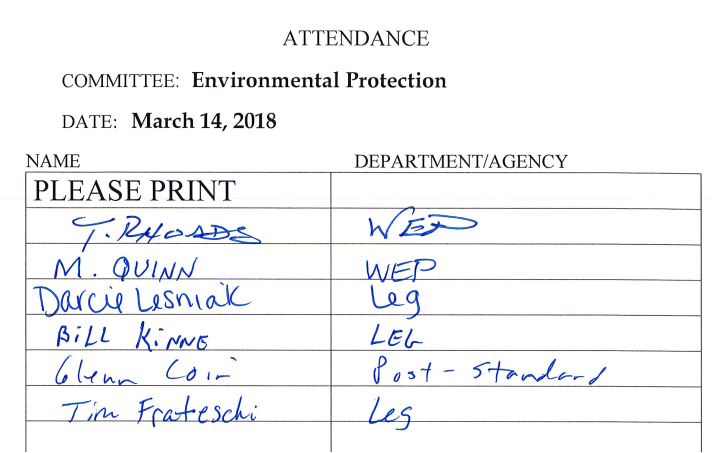
* * *
COUNTY FACILITIES COMMITTEE MINUTES – MARCH 14, 2018
JUDITH A. TASSONE, CHAIR
MEMBERS PRESENT: Ms. Cody, Mr. Holmquist, Mr. Knapp, Mrs. Ervin
ALSO ATTENDING: Chairman McMahon, Mr. Bush; see attached list
Chair Tassone called the meeting to order at 10:36 a.m. A motion was made by Mr. Knapp, seconded by Mrs. Ervin to waive the reading of the minutes of the previous committee meeting; MOTION CARRIED. A motion was made by Mr. Knapp, seconded by Ms. Cody to approve the minutes of the previous committee meeting; MOTION CARRIED.
1. TRANSPORTATION: Martin Voss, Commissioner
a. Authorizing Execution of Agreements for Gaining Access and Use of Property Owned by New York State Located Along the Western Shore of Onondaga Lake
-
Chris Rauber, Civil Engineer 3 - handles federal aid work, getting money for projects, and serves on multiple Syracuse Metropolitan Transportation Council (SMTC) committees for federal and state funding
-
Contract agreement with NYS for this year’s section of Loop the Lake; allows contract with NYS DOT and DEC for access onto property; hope to start this year

-
West Shore Trail parking lot to Honeywell; Honeywell trailers used by NYS Dept. of Transportation (DOT); Marcy construction bought them from NYSDOT; objective to get design approval, and get bid started
-
Item a allows access onto property; no cost to County
-
0.6 miles; lot of people fighting over small piece of land, because of a number of projects happening including the boat launch, WEP pump station, Honeywell, OCDOT, staging for Orange Lot construction, etc.
-
Meeting with DEC and everyone to ensure all are on same page with schedules and time constraints
-
Green stuff on map is the Honeywell project – not DOT’s responsibility
-
County piece of trail will be box culvert
Mr. Rauber commented that there is a capture system (for green area), and the ditch has not been remediated yet. It will be Honeywell’s next phase of work. Mr. Voss said it is probably an older GPS photo as well.
Mr. Voss responded to Mr. Knapp that it will be a box culvert into the ditch, and the material from the ditch will flow through. Mr. Knapp asked what path the trail will be on. Mr. Voss replied that it is still being designed. Also, there is a Honeywell Pump Station that has to come out.
A motion was made by Mr. Knapp, seconded by Ms. Cody, to approve this item. Passed unanimously; MOTION CARRIED.
b. Amending the 2018 County Budget to Fund in the First Instance 100 Percent of the Federal Aid Eligible Costs at a Maximum Amount of $1,512,000 for the Construction and Construction Inspection Phases of the Onondaga Lake Canalways Trail Phase I Project, Pin 3950.49, and Authorizing Execution of Agreements ($1,512,000)
-
Pay in first instance – when doing federal aid project, the Federal Government contributes 80% of cost of projects, State and County come up with 20%; NY projects typically 80% federal, 15% state, 5% local
-
Each project requires Legislative approval to understand what the money is for and what it is being spent on
-
Reimbursement process - County pays first instance, and is reimbursed by federal government through NYS
-
County DOT sets aside cash to pay bills; once paid, then prove its paid, and receive reimbursement
-
Construction stage inspection; overall cost of $1,890,000; federal share is $1.5mil and change; local is $378,000
Mr. Rauber noted that this is a trail project, and the state does not fund these types of projects. The local share is the full 20%. Mr. Voss stated that is the $378,000 that the Legislature approved spending out of the tobacco settlement money. This item gives the Comptroller permission to pay the bills. Mr. Voss responded to Mr. Knapp that it is the 0.6 miles. Mr. Rauber said it is from the Orange Lot to where the Honeywell property starts. Mr. Knapp clarified that the federal government is picking up the 80%, and the County share is coming from the settlement. Mr. Voss agreed.
A motion was made by Mrs. Ervin, seconded by Mr. Knapp, to approve this item. Passed unanimously; MOTION CARRIED.
c. INFORMATIONAL: Update on Status of Various County Infrastructure and Overview of 2018 Work Plan
-
Thank for the opportunity to be here to talk about infrastructure, and work plan bond proposal
-
Maintain 791 miles of County road; state does not update the number every year; recently started using GIS mapping
-
County divided into North Area (Molloy Rd.), Camillus (close to reopening), Marcellus and Jamesville
-
Stantec (vendor) uses radar ever year to test condition of pavement, which gives baseline rating on condition of roads, so they can determine what needs to get fixed, what can wait, what needs pavement preservation; avg. 1 quadrant/year
-
SMTC looks at federally classified roads: federally eligible because of designation, higher volume, principle arterials and collector roads; visual survey done every couple years; put results on web; current is March 2017
-
Vendor used comes up with avg. rating of County roads at 7.1 (out of 10); SMTC rating is the same
-
Data helps to justify and articulate what the County needs through SMTC to get projects done
-
240 bridges – some classified are not always a bridge; could be box culvert or pipe underground that carries water
-
117 are traditional bridges with 20 ft. span or greater; 123 local bridges smaller than 20 ft. that are mostly culverts and round box; state DOT does all 20 ft. or greater in NYS; helps drive funding decisions at SMTC
-
Anything over 20 ft. needing repair will be federal aid project
-
70% of County owned bridges in good shape; 30% require maintenance
-
Since 1960’s, transition away from municipalities owning them, because of cost of repair; also transition from County owning to turning over to state; state bridges rated poorly from SMTC
-
Bridge repair is ongoing multiyear process; (i.e.) federal aid project on John Glenn at outlet to Onondaga Lake
Mr. Voss played a video done by B&L of John Glenn Bridge construction over the outlet to Onondaga Lake.
- John Glenn Blvd. bridge project - $4.5 mil 2 year project; B&L is engineer; Vector is the contractor
- Shut down one lane in 2017, completed one side and will shut down other side this spring; will let know when
- Will be done at the end of 2018 construction season; other side to shut down hopefully in few weeks
- Contractors waiting to work; cannot do until they know snowplows will not wreck the work; could be April 1st or 15th
- B&L did great job; Vector a pleasure to work with as well - on schedule and within budget
- Closed walking trail beneath – construction equipment is there
Salt Springs Road:
 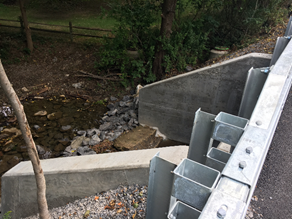
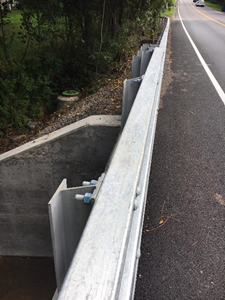 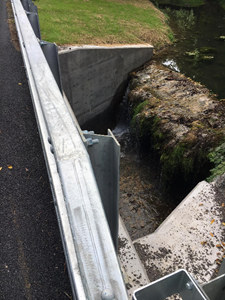 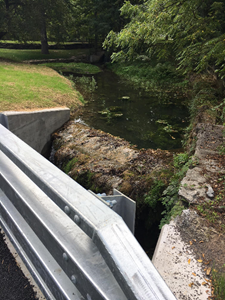
- Salt Springs Road; locally funded, contracted out bridge project; Vector is the vendor; $400,000
- Replaced guiderail; concrete is box; Limestone Creek
Highbridge Street:
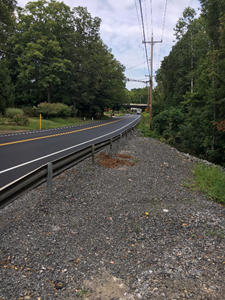 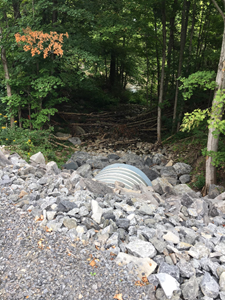 
Exeter Street Bridge:
 
  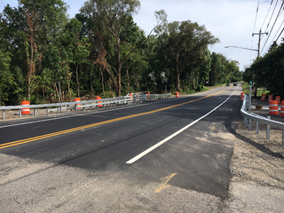
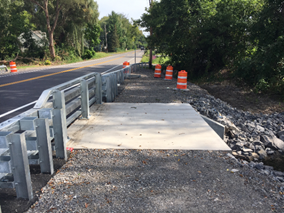
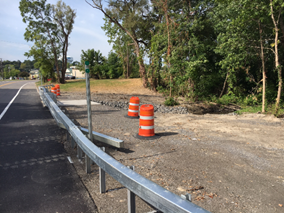 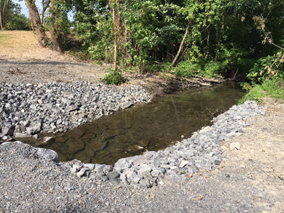
- Exeter St. bridge – County bridge that’s shorter, less expensive, not federal aid; repaired with local money
-
In Dewitt off Thompson North, James St.; Thompson across intersection where Burn Dairy is
-
Identified need to replace culvert; Town of Dewitt had concerns, so met with Supervisor and Planning Dept.
-
Town had to move sewers for County to put box culvert in
-
Town Planning Dept. had work on Thompson Road (i.e. new Dunkin Donuts) - asked County to increase width of bridge and box culvert to accommodate sidewalks; County does not own or do sidewalks
-
Town of Dewitt paying for extra pieces of box culvert and incorporation into project; doing with own forces
-
Box culvert like giant pieces of Lego that fit in tongue and groove; overlaps on itself on either side; precast concrete
-
Capstone piece at end of box culvert shown above; merely finished product; extra room for sidewalk project
-
Less expensive and lasts longer than traditional bridge; precast pieces save time and money in field installing
-
Done in summer when dry
-
$235,000 in materials not including Town contribution for additional width, equipment rentals, County forces and labor
West Valley Road:
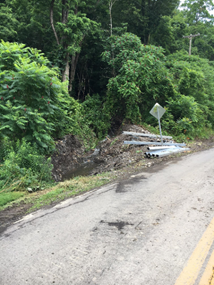 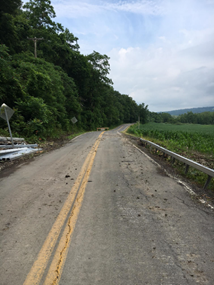 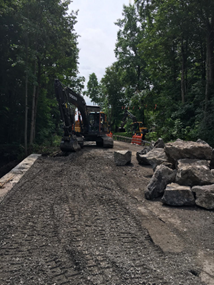
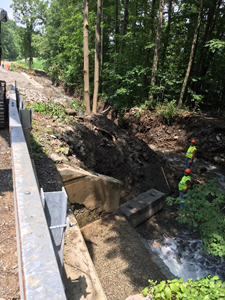  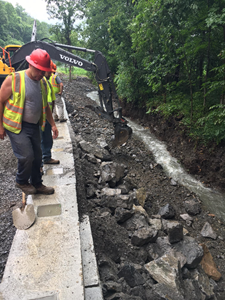
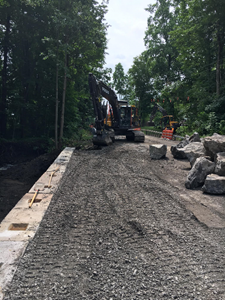 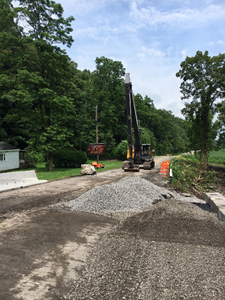 
-
Emergency repairs – epic rain storm on July 1 last summer
-
West Valley Road runs along Otisco Lake in Town of Spafford; took beating; roads closed and damaged
-
Otisco Lake off to right; had to rebuild entire culvert and put in new pipe; water made its own path through woods
-
Took tour after storm with Town of Spafford and Pompey – Pompey also had damage
-
Repair started July 4th weekend; got guiderail back up; replacing blocks; then July 10th had another storm, which washed away 1/3 of work that had been done
-
Cranes rented; use as needed; more economical to rent
- Stream is about 14-15’ down
Mr. Voss continued on to the Work Plan:
-
Funding projects takes a number of pieces to come together
-
MPOs (Metropolitan Planning Organization) all over the country that exist to bring stake holders together (towns, counties, villages, state)
-
MPOs assess and evaluate projects based on need; committees make decisions on how transportation funding will work from the federal government; this provides a clear understanding of how the money flows for everyone
-
When have federal aid projects, advance them, then deadlines for design, approval, bidding, etc.; have to demonstrate credibility through the whole process in order to keep federal money flowing
-
Work plan next month includes:
-
Federal aid projects - long term multiyear projects; i.e. John Glenn Blvd.
-
Traffic system management - traffic lights, crossings
-
Cold mix bituminous reconstruction - secondary road network, i.e. rural, less traveled roads
-
Hot mix bituminous network – main network of County roads with blue and yellow signs
-
Guiderail - replaced when damaged
-
Bituminous surface treatment - part of pavement preservation technique
-
Objective to keep good roads good, and minimize frequency of complete reconstruction
-
Complete reconstruction is very expensive; bituminous gives ability to patch and keep things good longer
-
Testing, draining and facility repair – testing with Stantec to check pavement quality; also drainage equipment
-
Sources of revenue – operating budget (local cash), Consolidated Highway Improvement Program (CHIPS), and any other NYS special cash funds like Pave NY, Bridge NY or Emergency Winter Recovery (last year $700,000)
-
Cannot say whether the County will get that again or not; changes every year; will present reasonable conservative number; CHIPS should be funded at least at the same level as last year
-
Use bonded debt (local borrowing) to cover work plan, and fed aid with 80% match – biggest portion is federal aid
-
Also have one time local revenues like the tobacco funds; last year came to the Legislature for 2 year spending plan of tobacco money on local share of bridge work
-
Go through this process every year; once snow melts will see what there is to deal with, what’s bad, what needs to be done, and what has come up over the winter
-
Started 2017 work plan with local share at $1,394,000 cash; cut in July last year by $1 mil; bonding resolution $4.6 mil
-
2018 budget had $394,000 cash after $1 mil cut; cut down another $100,000 to total $294,000 cash current year
-
Anticipate seeking authorization for work plan bond of $5.7 mil ($4.6 mil last year plus the $1 mil cut in cash)
-
Uncertainty with fed aid program; 80/20 match is great, but one position saying it will be inverted to 20/80; County would do a lot less work; State sources typically not as reliable; consider and anticipate doing what did last year
-
In light of this, will look at and asses the work, then develop the plan; will react accordingly to whatever the state and federal government do in regards to funding
-
Goal to leverage maximum amount County can get back from Washington and Albany; spend local share frugally; get as much back in other revenues
-
Price of asphalt directly related to petroleum – spike in gas prices can spike asphalt prices
-
Will have work plan bonding resolution in for consideration next month at Facilities, and Ways and Means
-
Will submit list in work plan, and matrix of funding; will have specific project list divided by highway garage (i.e. Camillus)
- Infrastructure in relatively stable condition - try to make everything better in due course, and leverage fed and state aid
Mr. Knapp asked if they have been doing a pothole assessment. Mr. Voss replied:
-
Couple came up that were bad that had to be dealt with; when it’s at a point of bottoming out a snowplow, it has to be filled to make it through winter; even if the fill is scraped off
-
DOT typically does shift change from winter to summer schedule mid-April to early May
-
Trying to get all the paperwork processed in purchasing for federal aid projects in the cue; when weather breaks, can get the vendors out working as soon as possible
Mr. Knapp believes it was 2 years ago when the County had a mild winter, and was penalized by New York State by holding back a percentage of the snowplow contract. Mr. Knapp asked where they are this year. Mr. Voss does not. In Mr. Voss’ opinion, this winter has been worse than last year, because of the sustained duration of the storms. Also, there has been a problem with the warm ups where the water gets underground, then freezes, and causes cracking. Mr. Knapp said when NYS cut the funding, the County still kept the towns whole. Mr. Voss said they always keep the towns whole. Mr. Knapp stated the County usually pays the towns out of the severity factor. Mr. Voss commented that it was renewed last year, and everyone including towns, villages and Cayuga County signed on. There is a small portion Cayuga handles for the County, because of the gas to get out there. With reductions in staff and no new snowplows in 3 years, it allows DOT to do the baseline with less.
Mr. Voss asked if items a and b will go to Ways and Means. Chair Tassone said no; there is no money for a. Mr. Knapp agreed, and said item b will.
The meeting was adjourned at 11:14 a.m.
Respectfully submitted,

JAMIE McNAMARA, Assistant Clerk
Onondaga County Legislature
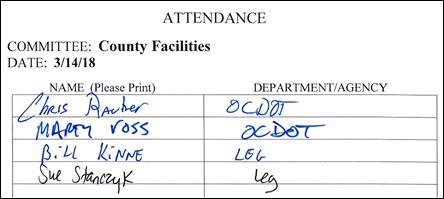
* * *
PUBLIC SAFETY COMMITTEE MINUTES - MARCH 14, 2018
CHRISTOPHER J. RYAN, CHAIRMAN
MEMBERS PRESENT: Mr. Bush, Mr. Jordan, Mr. Rowley, Mr. McBride
ALSO ATTENDING: Mr. Knapp, Mrs. Ervin; see attached list
Chairman Ryan called the meeting to order at 12:03 p.m. A motion was made by Mr. Rowley, seconded by Mr. Jordan, to waive the reading of the proceedings from the previous committee. MOTION CARRIED. A motion was made by Mr. Jordan, seconded by Mr. Rowley, to approve the minutes from the previous committee. MOTION CARRIED.
1. DISCUSSION: Revisions to Adrian’s Law
Chairman Ryan said that two local laws were proposed at the last session. The majority of the body requested that it be sent back to committee to see if we could come up with one law. We are not quite there yet, for a couple different reasons. Minor revisions were made to this rough draft for discussion:
For Discussion Purposes
03.14.2018
LOCAL LAW NO. _____ - 2018
A LOCAL LAW PROTECTING AND PROVIDING FOR THE HEALTH AND WELL-BEING OF DOGS IN ONONDAGA COUNTY, AND AMENDING LOCAL LAW NO. 5 - 2017
BE IT ENACTED BY THE COUNTY LEGISLATURE OF THE COUNTY OF ONONDAGA, AS FOLLOWS:
Section 1. Findings/Purpose.
Often referred to as “man’s best friend”, dogs are companions, valued for the animals’ loyal behavioral traits and ability to be kept in close proximity to people in domestic situations. Some dogs are left outdoors without means to protect themselves. These animals are exposed and vulnerable to changing weather conditions. In Onondaga County, weather conditions are famously known to change quickly and dramatically. By way of example, dangerous conditions include: temperatures at extreme ends of the spectrum, subzero wind chills, sun, thunderstorms, and high humidity. No dog should be left outside, tethered and exposed to the weather for prolonged periods when the temperature falls below the freezing point of water. With temperatures below the freezing point, a dog may experience harm and damage to its skin, causing pain. Similarly, dogs left outside, tethered and exposed for prolonged periods when the temperature rises to greater than 90° Fahrenheit are believed likely to experience heatstroke or other bodily harm.
Consistent with Municipal Home Rule Law section 10(1)(ii)(a)(12), this local law protects and provides for the health and well-being of dogs in Onondaga County by regulating the manner in which dogs may be kept outdoors. This local law is intended to provide greater protection for dogs than found within New York State Agriculture and Markets Law Sections 353-b and 353 at the time of adoption. Humane treatment of dogs not only provides these animals with a better quality of life, but may also reduce the likelihood of dogs having harmful behaviors towards other animals. It is believed that most dogs tethered outside for prolonged periods do not have adequate protection.
Specifically excluded from coverage under this local law shall be those dogs who are used as working dogs or hunting dogs, as it is believed that the risks of harm to such dogs is not present in the same way.
Section 2. Regulations.
(a) Prohibition.
No person who owns or has custody or control of a dog shall knowingly leave such dog tethered outdoors for longer than a period of 2 continuous hours at such time as when either (1) the actual air temperature is lower than 32° Fahrenheit (not accounting for wind chill), (2) the actual air temperature is greater than 90° Fahrenheit (no accounting for humidity levels), or (3) during such period of time as extreme weather conditions exist, where any such condition in (1), (2), or (3) above is actually known to such person or reasonably should have been known to such person. Actual harm or injury need not be shown to prove a violation of the prohibition in this subsection.
(b) Rebuttable Presumptions.
Extreme weather conditions shall be presumed to have been present in the event that a weather alert was in effect for a region reasonably construed and commonly understood to be affecting the region in which the dog was left outdoors and during such time as the dog was left outdoors.
A dog exhibiting signs of frostbite shall be presumed to have been left outdoors for longer than a period of 2 continuous hours at such time as when the actual air temperature was lower than 32° Fahrenheit.
A dog exhibiting signs of heatstroke shall be presumed to have been left outdoors for longer than a period of 2 continuous hours at such time as when the actual air temperature was greater than 90° Fahrenheit.
(c) Exceptions.
This local law shall not apply:
- to working dogs;
- to hunting dogs:
- to dogs on a leash or other restraint under direct supervision or control of persons actively engaged in recreational activities, including walking, jogging, or running; and
- to dogs required to be tethered under an applicable law, rule, regulation, or court order.
(d) Definitions.
For purposes of this local law, the terms listed below have specific definitions, as follows.
- “extreme weather conditions” shall include inclement weather, being weather conditions that are likely to adversely affect the health or safety of the dog, including but not limited to rain, sleet, ice, snow, wind, or extreme heat and cold, and otherwise consistent with the provisions of New York State Agriculture and Markets Law Section 353-b(1)(b), as may be amended from time to time.
- “weather alert” shall mean a broadcast of the National Weather Service regarding one of the following weather-related events, reasonably construed to be affecting the region in which the dog was left outdoors: blizzard warning, severe thunderstorm (watch or warning), severe weather statement, tornado (watch or warning), winter storm (watch or warning).
- “outdoors” shall mean a location outside a permanent structure capable of habitation or occupancy by people during an extreme weather event or period of time with temperatures falling below 32° Fahrenheit or greater than 90° Fahrenheit (depending on the applicable weather conditions), such as a house, apartment building, or office building. Examples of non-suitable outdoor structures include, without limitation, wire cages and non-insulated structures, including those made of plastic (e.g., calf hutch).
- “tether” shall include the actions of leashing, fastening, securing, chaining, tying, or otherwise restraining a dog to any stationary object outdoors.
- “working dog” shall mean any dog that is trained to herd and/or protect livestock, control bird and/or wildlife populations, or otherwise is actually or has been used in connection with farming or agricultural purposes.
- “hunting dog” shall mean any dog that is trained to aid in taking of wildlife and is actually or has been used for such purposes, consistent with applicable law or regulation, including Environmental Conservation Law Section 11-0923, and local permits.
Section 3. Enforcement, Penalties, and Registration Obligations.
(a) Enforcement Officers.
This local law shall be enforced by the Onondaga County Sheriff’s Office, or designee, and may also be enforced by any police officer, local dog control officer, peace officers, animal control officer, New York State Police, having jurisdiction within Onondaga County, or any other officers as may be designated by the Onondaga County Legislature via resolution from time to time (where any such officer shall be an “enforcement officer”). Such enforcement officers shall have the authority to enforce the provisions of this local law and to take such necessary and related enforcement actions, including, without limitation, accepting, recording, and investigating complaints, issuing appearance tickets, obtaining supporting depositions, and preparing and submitting criminal and civil complaints to a court of competent jurisdiction.
(b) Classification of Offense.
Any person who violates the prohibition found within Section 2(a) of this local law, shall, upon conviction thereof, be guilty of a violation, as defined in Section 55.10 of the New York State Penal Law, as may be amended from time to time. Each calendar day in which such person violates Section 2(a) of this local law shall constitute a separate offense.
(c) Penalties and Registration.
The court, in its discretion, may impose a sentence of imprisonment to be fixed by the court for a term not to exceed fifteen days, consistent with Section 70.15(4) of the New York State Penal Law, a sentence to pay an amount to be fixed by the court not exceeding the amount of two hundred fifty dollars, consistent with Section 80.05(4) of the New York State Penal Law, or both.
The court may also elect to cause the dog(s) underlying the basis of the conviction to be surrendered or otherwise forfeited by the person after such conviction. The surrender or forfeiture shall be to an enforcement officer, as provided herein above.
In lieu of or in addition to any other penalty imposed under this local law, the court may impose upon any person who fails to comply with Section 2 of this local law a civil penalty, enforceable and collectable by Onondaga County, in the amount of two hundred fifty dollars for a first offense, five hundred dollars for a second offense, and one thousand dollars for each additional offense.
Conviction of a person under this local law shall require such person to register with the Animal Abuser Registry as an Animal Abuse Offender and to comply with the entirety of Local Law No. 5 - 2017, as amended herein below.
(d) Disposition of Fines.
All fines collected pursuant to this local law shall be the sole property of Onondaga County, kept and accounted for separately, to be used for promoting animal welfare within Onondaga County, including, programs of public education.
Section 4. Severability.
If any clause, sentence, paragraph, section, subdivision or other part of this Local Law or its applications shall be adjudged by a Court of competent jurisdiction to be invalid or unconstitutional, such order or judgment shall not affect, impair, or otherwise invalidate the remainder of this Local Law which shall remain in full force and effect except as expressly limited by such order or judgment.
Section 5. Effect on Existing Local Legislation.
Local Law No. 5 - 2017, establishing an Animal Abuser Registry, is hereby amended such that the definition of an “Animal Abuse Crime” shall now include New York State Agriculture and Markets Law Section 353-b – Appropriate Shelter for Dogs Left Outdoors within subsection (a) thereof and shall now include a new subsection (f) to read as follows: “Violating local laws enacted by Onondaga County providing for the health and well-being of dogs in Onondaga County, including the local law passed on April 3, 2018, becoming effective on May 1, 2018.”
Section 6. Reverse Preemption.
This law shall be null and void on the day that statewide or federal legislation goes into effect, incorporating either the same or substantially similar provisions as are contained in this law, or in the event that a pertinent State or Federal administrative agency issues and promulgates regulations preempting such action by the County of Onondaga. The Onondaga County Legislature may determine via resolution whether or not identical or substantially similar statewide legislation has been enacted for the purposes of triggering the provisions of this section.
Section 7. Effective Date.
This local law shall take effect on May 1, 2018, and shall be filed, consistent with the provisions of the Municipal Home Rule Law.
Chairman Ryan:
-
Modifications made for working and hunting dogs, under exceptions - states this local law shall not apply to working dogs or hunting dogs, under tethering - defines what a working dog and hunting dog is, dates also changed, all penalties, regulations and presumptions are the same, initial intent was to not included those, felt if dog was working or hunting it would not be tethered but that may not always be the case, made sure this is specifically cared for
- At the same time Mr. Jordan made modification to his law with regard to sheltering
LOCAL LAW NO.___-2018
A LOCAL LAW PROTECTING AND PROVIDING FOR THE HEALTH AND WELL-BEING OF DOGS AND OTHER COMPANION ANIMALS IN ONONDAGA COUNTY, AND AMENDING LOCAL LAW NO. 5-2017
BE IT ENACTED BY THE COUNTY LEGISLATURE OF ONONDAGA COUNTY AS FOLLOWS:
Section 1. Findings/Purpose.
Consistent with Municipal Home Rule Law Section 10(1)(ii)(a)(12), this local law protects and provides for the health and well-being of dogs and other companion animals in Onondaga County by regulating the manner in which such animals may be kept outdoors. This local law is intended to provide greater protection for dogs and other companion animals than found within New York State Agriculture and Markets Law Sections 353-b and 353 at the time of adoption. Humane treatment of dogs not only provides these animals with a better quality of life, but may also reduce the likelihood of dogs having harmful behaviors towards other animals.
Section 2. Definitions
For purposes of this local law, the terms listed below have specific definitions, as follows:
- “Companion animal” shall mean any dog or cat, and shall also mean any other domesticated animal normally maintained in or near the household of the owner or person who cares for such other domesticated animal. “Companion animal” shall not include a “farm animal” as defined in Section 350(4) of the New York State Agricultural and Markets Law, as may be amended from time to time. “Companion animal” shall also not include animals under direct supervision or control of the owner or person who cares for such companion animal, including, but not limited to, companion animals on a leash or other restraint with persons walking, jogging, hunting or running with the companion animal, nor shall it include livestock herding or guardian dogs commonly utilized by farms and/or in connection with farming operations, or to dogs actively involved in legal hunting or attending performance events such as, but not limited to, dog shows, field agility trials or other organized animal events
-
“Physical condition” shall include any special medical needs of a companion animal due to disease, illness, injury, age or breed about which the owner or person with custody or control of a companion animal should reasonably be aware.
- “Inclement weather” shall mean weather conditions that are likely to adversely affect the health or safety of a companion animal, including but not limited to rain, sleet, ice, snow, wind, or extreme heat and cold, as defined in Section 353-b of the New York State Agricultural and Markets Law, as may be amended from time to time.
- “Companion animals that are left outdoors" shall mean companion animals that are outdoors in inclement weather without ready access to, or the ability to enter, a house, apartment building, office building, or any other permanent structure that complies with the standards enumerated in Sections 3(a) of this local law.
- “Tethered” shall include the actions of leashing, fastening, securing, chaining, tying or otherwise restraining a companion animal to any stationary object outdoors.
Section 3. Regulations
(a) Any person who owns or has custody or control of a companion animal that is left outdoors shall provide it with adequate shelter from inclement weather appropriate to its breed, physical condition and the climate.
(b) Any person who owns or has custody or control of a companion animal that is left outdoors shall provide proper food and water so as not to impair the health of the companion animal.
(c) No person who owns or has custody or control of a companion animal shall knowingly leave a companion animal tethered outdoors, unattended, for such a period of time as to adversely affect the health or safety of such companion animal.
(d) No person shall subject a companion animal to prolonged exposure to inclement weather such that it
(1) results in hypothermia, hyperthermia, frostbite, or similar condition as diagnosed by a doctor of veterinary medicine; or
(2) results in other injuries or death related to exposure to inclement weather.
Section 4. Rebuttable Presumptions
(a) That with respect to 3(a) above, a companion animal shelter is presumed adequate if the shelter (1) has a waterproof roof; (2) is structurally sound so as to protect the companion animal from the inclement weather; (3) is appropriate for the companion animal's breed and physical condition, and the climate; (4) has insulation appropriate to local climatic conditions and sufficient to protect the companion animal from inclement weather after taking into account other measures taken by an owner or custodian to maintain the companion animal’s body temperature and to protect the companion animal from inclement weather; (5) has four connected sides and a raised floor; (6) has a door maintained in good repair that prevents the entry of drafts and precipitation, and allows the accumulation of body heat, (7) is constructed to allow each companion animal adequate freedom of movement to make normal postural adjustments, including the ability to stand up, turn around and lie down with its limbs outstretched; and (8) allows for effective removal of excretions, other waste material, dirt and trash and the facility and the area immediately surrounding it are regularly cleaned to maintain a healthy and sanitary environment and to minimize health hazards. For companion animals that are restrained in any manner outdoors in an enclosure, such enclosure shall be set on a solid foundation, such as stone or concrete, or solid ground that is well drained and free of standing water. For companion animals that are restrained in any enclosure, whether indoors or outdoors, the animal shall be provided with dry bedding and/or solid resting boards so as to conserve its body heat during periods of cold weather and under no circumstance shall a companion animal be forced to lie on a damp surface or upon unheated concrete or stone during periods of cold temperatures, if doing so would result in the loss of body heat.
(b) That with respect to 3(c) above, adverse effects on the health or safety of a companion animal shall be presumed if a companion animal has been tethered outdoors unattended for a period of time longer than 2 continuous hours and (1) the actual air temperature is lower than 10º Fahrenheit (not accounting for wind chill), (2) the actual air temperature is greater than 90º (not accounting for humidity levels) or (3) during such a period of time as extreme weather conditions exist, where any such condition in (1), (2) or (3) above is actually known to such person or reasonably should have been known to such person, has been left outdoors for a time period or in such a fashion as to adversely affect the health or safety of such companion animal. Nothing in the aforementioned designated temperatures and time periods should be viewed as indicating that the same are necessarily safe or appropriate for all companion animals or for all breeds of companion animals.
Section 5. Enforcement and Penalties
(a) Enforcement Officers.
This local law shall be enforced by the Onondaga County Sheriff’s Office, or designee, and may also be enforced by any police officer, local dog control officer, animal control officer, New York State Police, having jurisdiction within Onondaga County, or any other officers as may be designated by the Onondaga County Legislature via resolution from time to time. Such enforcement officers shall have the authority to enforce the provisions of this local law and to take such necessary and related enforcement actions, including, without limitation, accepting, recording, and investigating complaints, issuing appearance tickets, obtaining supporting depositions, and preparing and submitting criminal and civil complaints to a court of competent jurisdiction.
Enforcement officers may take any and all necessary steps to remove a companion animal pursuant to this local law. Upon removal of a companion animal, enforcement officers shall place a written notice at the location where the companion animal was kept, bearing the name of the officer, and the department or agency and address where the companion animal(s) will be taken. A companion animal removed pursuant to this local law shall immediately receive emergency veterinary treatment, and the condition of said animal shall be documented prior to delivering the companion animal to the department or agency where the companion animal will be sheltered.
(b) Classification of Offense.
Any person who knowingly violates the regulations set forth in Section 3 of this local law, shall, upon conviction thereof, be guilty of a violation, as defined in Section 55.10 of the New York State Penal Law, as may be amended from time to time.
(c) Penalties and Registration.
For a first offense, the court, in its discretion, may impose a fine of not less than fifty dollars nor more than two hundred fifty dollars. For second or subsequent offenses, the court may impose a fine of not less than one hundred dollars nor more than five hundred fifty dollars, or imprisonment for not more than fifteen days consistent with Section 70.15(4) of the New York State Penal Law, or both such fine and imprisonment.
The court may also elect to cause the dog(s) underlying the basis of the conviction to be surrendered or otherwise forfeited by the person after such conviction. The surrender or forfeiture shall be to an enforcement officer, as provided herein above.
Beginning seventy-two hours after a charge of violating Section 3 of this local law, each day that a defendant fails to correct the deficiencies identified in order to be in compliance with this local law shall constitute a separate offense. The aforementioned period of time may be extended, however, in the discretion of a Court of competent jurisdiction, upon a showing by a defendant that reasonable efforts have been undertaken to correct any alleged deficiencies, but have not been able to be completed.
In lieu of or in addition to any other penalty imposed under this local law, the court may impose upon any person who fails to comply with Section 3 of this local law a civil penalty, enforceable and collectable by Onondaga County, in the amount of two hundred fifty dollars for a first offense, five hundred dollars for a second offense, and one thousand dollars for each additional offense.
The court may, in its discretion, reduce the amount of any fine and/or or civil penalty imposed for a violation of this local law by the amount which the defendant proves he or she has spent to come into compliance with the requirements of this local law. Nothing in this paragraph shall prevent the seizure of a companion animal for a violation of local law.
Upon a finding of any violation of this section, any companion animal or companion animals seized pursuant to the provisions of this article that have not been voluntarily surrendered by the owner or custodian or surrendered pursuant to court order shall be returned to the owner or custodian only upon proof the defendant has come into compliance with the provisions of Section 3 of this local law, any fine imposed has been paid and/or the completion of any sentence of imprisonment imposed for violation of this local law.
Upon two or more convictions of a person under this local law, the prosecuting agency shall forward the name and address of the offender to the Onondaga County Sheriff’s Office for entry on the Animal Abuser Registry as an Animal Abuse Offender and to comply with the entirety of Local Law No. 5 - 2017, as amended herein below.
(d) Disposition of Fines. All fines collected pursuant to this local law shall be the sole property of Onondaga County, kept and accounted for separately, to be used for promoting animal welfare within Onondaga County, including, programs of public education.
Section 6. Severability.
If any clause, sentence, paragraph, section, subdivision or other part of this Local Law or its applications shall be adjudged by a Court of competent jurisdiction to be invalid or unconstitutional, such order or judgment shall not affect, impair, or otherwise invalidate the remainder of this Local Law which shall remain in full force and effect except as expressly limited by such order or judgment.
Section 7. Effect on Existing Local Legislation.
Local Law No. 5 - 2017, establishing an Animal Abuser Registry, is hereby amended such that the definition of an “Animal Abuse Crime” shall now include New York State Agriculture and Markets Law Section 353-b – Appropriate Shelter for Dogs Left Outdoors within subsection (a) thereof and shall now include a new subsection (f) to read as follows: “Violating local laws enacted by Onondaga County providing for the health and well-being of dogs in Onondaga County, including two or more violations of the local law passed on April 3, 2018, becoming effective on May 1, 2018.”
Section 8. Reverse Preemption.
This law shall be null and void on the day that statewide or federal legislation goes into effect, incorporating either the same or substantially similar provisions as are contained in this law, or in the event that a pertinent State or Federal administrative agency issues and promulgates regulations preempting such action by the County of Onondaga. The Onondaga County Legislature may determine via resolution whether or not identical or substantially similar statewide legislation has been enacted for the purposes of triggering the provisions of this section.
Section 9. Effective Date.
This local law shall take effect May 1, 2018, and shall be filed consistent with the provisions of the Municipal Home Rule Law.
Mr. Jordan:
-
Had dogs entire life, don’t profess to be a veterinarian, did research; October 2017 article by Dr. Kim Smyth, DVM, contained a chart based upon the Tufts Animal Condition and Care System, broken down in terms of what was too cold for a particular dog, doesn’t factor in age, condition, health or exercise of the dog, numbered 1 to 5, from no evidence of any risk, to potentially life-threatening cold, avoid prolonged outdoor activity
-
Chairman’s provisions incorporated into this law, some literature suggests 0° is the limit at which all dogs are in peril, went in between because 10° is the temperature where virtually every dog is in a life-threatening situation
-
10° is the yardstick for his law, that being said, every dog is different, even the same breed can be different depending the on the age, heath, etc.; law doesn’t limit an enforcement officer from prosecuting for hypothermia or injury regardless of outside duration or temperature
-
Understand current state law was not definitive enough in terms of providing guidelines to animal owners for safe temperatures of pets, tried to address that concern and allow for the fact that every dog is different, even within breeds, allows flexibility in terms of prosecuting even when within the parameters set forth and provides guidance to animal owners
-
Contains provisions for shelter, provides outline to dog owners in terms of what could be considered acceptable shelter, melds both concerns for better guidelines of dog owners and the concern of legitimate loving dog owners who have dogs out 24 hours per day, but usually have shelters or dog houses for them, and farm owners with working dogs that live with the herd in the field, allows more discretion for animal officers, can look at situation and determine if the animal is truly at risk and if so prosecute
Chairman Ryan said that the public does not usually have an opportunity to speak at program committee. However, he invited someone from Associated Dog Clubs of NY, and an industry professional, to speak to some of the cases they see. He thought it would be best for this committee to hear from someone with firsthand knowledge and invited Marcie Marshall to speak. She is with the Veterinary Medical Center of East Syracuse. Chairman Ryan was notified that Ms. Marshall was not yet in the room. Chairman Ryan said that Daniel Cunningham was with the Associated Dog Clubs of NY, and also not present.
Mr. Jordan said that the Associated Dog Club approved his version unanimously. Chairman Ryan said that they did not like his. However, Mr. Cunningham reached out to him via email and was invited to speak. In fairness they have been working hard and we can agree to disagree; felt it was fair for them to have an opportunity to speak.
Ms. Marshall arrived at the meeting. Chairman Ryan advised Ms. Marshall that they are trying to come up with a law that speaks to the more human treatment of animals and they need to have an understanding of what really happens, what she sees firsthand.
Ms. Marshall:
-
In this field 26 years, what is seen in the media is just a tiny tip of what actually happens, probably 1-2 cases per day in extreme weather, either frozen or overheated dogs, primarily tethered animals, also overheated in cars
-
We are the only emergency and specialty animal hospital in Onondaga County and the greater Syracuse area, animals brought in by dog control, police or owner, see a variety of things, i.e., Airedale Terrier barked, tied outside in 90° with muzzle, could not pant, came in with temperature too high to measure – over 107°, already in a comma and dying, get frozen dogs when cold, even with overwhelming pleas from social media
-
Animals do ok when given their own ability to seek shelter, if running at large tend to find a place to get out of the cold, could have shelter nearby but unable to get to it, may wrap around a pole, etc.; overheating is a horrific death
-
Some of the more tragic things are County issues, expect issues in the City as animals suffer with poverty
-
Overheating happens as much as freezing, see it from everywhere, easily 2 or 3 per week
-
13 dogs almost froze in U-Haul, don’t hear about these things on the news, much bigger problem than most think
Mr. Bush asked if she would attribute this to irresponsible owners. Ms. Marshall responded that some of them may be responsible people who are uneducated or just don’t think about it. In some areas we see a dog short- chained to a lawnmower in 90° heat with a heavy black coat, in the sun, bark collar on, can’t bark or will be shocked. In other areas we question what they were thinking, may have dog on a runner, gets wrapped around a tree or pole and cannot get loose. Mr. Bush asked what happens with the owner in these cases. Ms. Marshall answered that, if we believe it is cruelty, we are obliged by our ethics to make a report similar to an emergency room. Mr. Bush asked whom the report is made out to. Ms. Marshall said that it is made out to authorities, depends on where the people live, maybe the SPCA, generally Officer Thompson in the City. Mr. Bush asked who it would be reported to in Lafayette. Ms. Marshall said that she would have to look it up. In answer to Mr. Bush, Ms. Marshall said that it is not usually reported to a police agency; call the sheriff as a last resort as it is not their focus, usually the SPCA or someone else does it. Mr. Bush questioned what would discourage an abuser from doing it again and if they have authority to remove the animal. Ms. Marshall responded that they have no authority to confiscate an animal. There are times when an animal comes in completely emaciated and they have to get permission to hospitalize it. Mr. Bush said that he was trying to determine how to mitigate a repeat situation. Ms. Marshall said that it is up to law enforcement.
- If cold and still alive can often get them back; overheated takes more time, effort, energy and money
Mr. McBride asked Ms. Marshal for her explanation of extreme weather conditions. Ms. Marshall said that it depends on the condition of the dog, the breed, how hot it is, if they access to shade; anywhere from the 80’s to 90’s, generally not under 80°. On the cold side, they see the most server in 0° and below; could be 25° but super windy, i.e. 2 cats froze in cat carrier located in a garage, wrapped together at 8°, no wind, depends on the situation, don’t know how you figure that out, it is variable.
Chairman Ryan thanked Ms. Marshall.
-
On animal cruelty task force, deal with cases from hospital prospective, not the medical part, prepare the documents and make sure the investigator has everything needed, take photos
- Really bothers her, complete waste, no reason for it, hopes something can come from this, about time we do something
Chairman Ryan said that we are trying to make a law that prevents this from happening again and if you think you have some picture that ….. Ms. Marshall interjected saying that she has a ton of pictures. Mr. Jordan said that it is impossible to pass a law that prevents this from ever happening. People break laws every single day, many times a day. He does not want to create an impression that we can craft a law that will absolutely prevent any dog from being left out when it is too cold or hot. Chairman Ryan said that if we can make a law that prevents what is currently happening, to use Ms. Marshall’s words, 2-3 times per week in cold weather and excessive heat, then at least we are doing something.
- Those are just the ones she sees, not the ones that get thrown in a creek or disposed of in another way
- All for small government, doesn’t mean the law isn’t a good thing to do, neighbor would then have cause to call and report; will email pictures
Chairman Ryan said that there were no official final draft laws to vote on today.
Mr. Rowley:
-
Encouraged both to get in a room and bang this out, sees good aspects in both laws
-
Concept of a time limit in the Chairman’s law makes sense from a practical standpoint; would be nice to be able to call and have someone check on an animal you are concerned about
-
Mr. Jordan’s law incorporates the whole idea of breed and brings one aspect of the Chairman’s law into it, tethering; breed is important, Saint Bernard lives across the street and stays in the snow for long periods and is ok but he gets concerned about the small dog next door who is put on a leash on the back porch and barks for an hour
Chairman Ryan:
-
Received a lot of feedback and asked a lot of people, not just those likeminded, for what his is trying to accomplish; asked if Mr. Rowley would propose different time limits for different breeds, doesn’t know how to do that.
Mr. Rowley:
- Then you go down that road; time element makes sense, don’t know how to incorporate breed too
Chairman Ryan:
Mr. Bush:
- Commended both legislators for the time, effort and work put into this; really above and beyond; this is very simple for some and very complex for others
-
Not a dog owner but heart wrenching to hear how animals are treated or neglected, would like something simple that everyone vested in the issue can come together on, might not be perfect but progress in the right direction
-
Would like the different animal groups to take the best parts of both and go with it; if the community can come to that conclusion he would feel very comfortable supporting it
Mr. Jordan said that he tried to merge the two proposal with his local law. Originally he did not have tethering, time periods and temperatures, those were pulled from the Chairman’s law. Mr. Bush said that there are people that want to see the situation to improve. We are almost there, if we could just get this put together so that folks are comfortable. Mr. Jordan said that this is the tenth version for his local law, which really incorporates almost all the input received.
Jason Driscoll:
-
Animal control officer, City of Syracuse; every law specifies dogs and does not get into breeds because a DNA test is the only way to know what a dog is
-
Would be very confusing if he had to go through a chart to determine what they are and what is acceptable; the law should say dog period, understanding that there are varying degrees depending on breed and health.
Chairman Ryan:
-
Companion animals are spoken to in the Ag and Markets Law, which is technically farm animals, do not think the law would, or should be, applicable; cats are not often tethered, his intention was dogs
-
Appreciate the definition of adequate sheltering but the modifications every dog owner would have to make to their existing shelter may be a little overreaching and cumbersome; if the dog is out in the cold for two hours the current adequate shelter as defined in Ag and Markets Law would be sufficient if they were just brought in
Mr. Jordan:
- His local law mirrors proposed changes to the state law, even the existing state law is substantially the same; only addition is some type of door or something hanging down, rain and wind increases the temperature to which the animal is ask risk, also must be adequately drained
- Companion animals specifically included because the danger is not limited to dogs; just because every provision of the local law will not apply to every single animal or case does not mean that it should not be included
- Tethering aspect was the point behind the Chairman’s local law, acknowledged this was a concern at the last session
- This is not a situation where everything is the same and we can pass a very tightly constructed law, breed, age, weather conditions, health and activity level all factor into susceptibility; don’t want to pass a law that is not the best that it can be
Ms. Marshall:
-
Sometimes it is a judgment call, someone else needs to step in and determine whether this is cruelty or just a tragic accident that nobody could have potentially prevented
-
From a community prospective the law needs to give law enforcement the ability to make a judgment call and simple enough that the community can say dogs can’t be left out below and over these temperatures and tethered; tethered has to be in whatever law you come up with
- Get calls from Good Samaritans, owners aren’t calling or bringing in their dog
Chairman Ryan said that the Syracuse Police department is a very big supporter and appreciates what we are doing. They are looking forward to getting something on the books that they can enforce. Mr. Jordan said that anyone interested could contact the legislature for an emailed copy of his final version, and feel free to contact him with any comments or questions.
Karen Antczak:
-
With Animal Alliance; law 353-b not adequate, too weak
-
Coordinates with Court Watch, go into every court for animal abuse cases in Onondaga County, see too much time being given to people to adjust their shelters
-
Need more teeth in what law enforcement and dog control is trying to do, finding animals already deceased or in need of amputation from hypothermia already experienced; 353-b just hand slapping
-
Applaud both for taking on this issue but if modeled after 353-b law enforcement needs stronger armament
Chairman Ryan thanked Ms. Antczak and said that there is more work to be done.
The meeting adjourned at 12:48 p.m.
Respectfully submitted,

KATHERINE M. FRENCH, Deputy Clerk
Onondaga County Legislature

* * *
PLANNING & ECONOMIC DEVELOPMENT COMMITTEE MINUTES - MARCH 15, 2018
JOHN D. McBRIDE, CHAIRMAN
MEMBERS PRESENT: Mr. Holmquist, Mr. Burtis, Mr. Plochocki
MEMBERS ABSENT: Mr. Buckel
ALSO ATTENDING: Chairman McMahon, Mr. Knapp; see attached list
Chairman McBride called the meeting to order at 10:37 a.m. A motion was made by Mr. Holmquist, seconded by Mr. Plochocki, to waive the reading of the proceedings of the previous committee. MOTION CARRIED. A motion was made by Mr. Holmquist, seconded by Mr. Plochocki, to approve the minutes from the previous committee. MOTION CARRIED.
1. VISIT SYRACUSE:
a. Informational: Tourism Improvement District - Danny Liedka, Executive Director
Mr. Liedka presented the following:
- Brought Kelly Carr from the Oncenter, spent time in CA where this concept is commonplace
 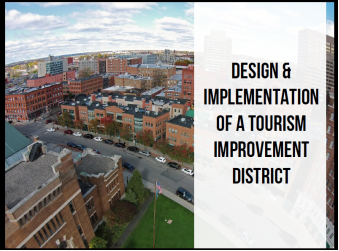

-
Additional dollar or percentage charge on hotel room bill would go to the district, not on the backs of local taxpayers, derived from travelers, i.e. NYC has about 8 different taxes or fees, one is for the Javits Center, this would be similar
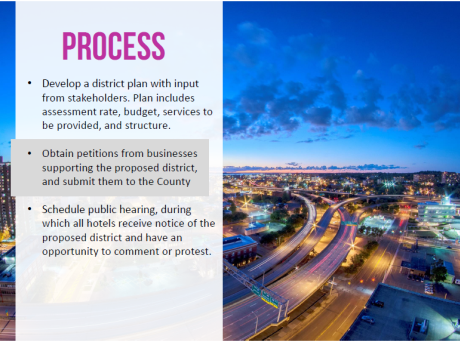
-
High level, not getting into the detail, want to give idea of the process and what he hopes to achieve, started with legislators because they will be an important component
-
First need a lot of public outreach with hotel owners to develop a plan, determine the board and best use for funds, larger hotels would have larger weighted vote in petition process
-
When plan is developed it can be broken out into districts, i.e. Carrier Circle, Liverpool, and the City-core, all part of the design process, would interject opinions of what is needed and where, ultimately up to the hotel owners to agree to the structure
-
Petitions from ownership groups in the proposed districts would be turned over to the County, a public hearing would be held in front of the legislature, prior to that there would be a public hearing for hotels proposed to be in the district to speak, would advance to the legislature if the numbers and petitions exceed 50%

-
Spoke with a few firms, including Civatas, the “NY Yankees” of TID’s, still need County’s opinion on level this would need to be approved at, his impression is the County level but this needs to be firmed up, would lean on County resources in Law to look at this also
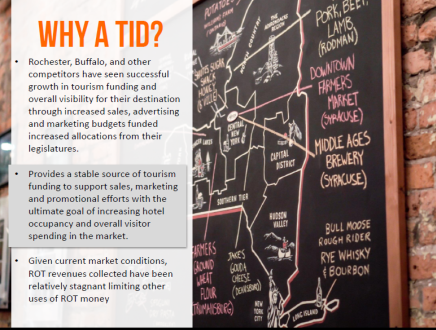
-
Why a TID is needed is the most important part, competitors growth has been 2% to 4% for the last several years; with this TID the contribution from room occupancy tax (ROT), as it is today, would stay the same for the life of the district, district could be 5 years, 1 year, however it is tailored
-
ROT money has grown slightly but still pretty stagnant, given current market conditions Syracuse has gone backwards in RevPAR, rate and occupancy, many new rooms in the market, think TID can help move the needle
-
Charging $2.00 per room night would generate $1.5M, funded at about $2M through ROT, would almost double their budget, would absolutely infuse millions of dollars, new money spent in this County - formulas provided further in presentation (See pg. 4)

-
5% growth would equate to $4.2M in new sales tax and $2.5M in ROT, super conservative, does not take into effect the growth in rate, as occupancy grows the rate grows, every dollar is like a million dollar multiplier; over the years they have heard a lot of formulas on economic impact, he is using barebones conservative numbers that he came up with and can quantify
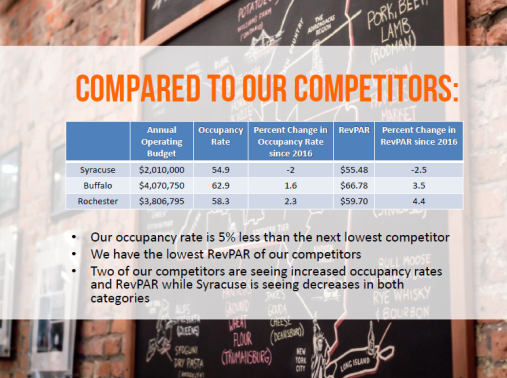
- Revenue per available room (RevPAR) troubling, removing NYC the statewide average is around $70.00, much opportunity for growth
-
Troubling numbers, notice competitors funding levels, can do more, i.e. Rochester has 30 employees that help sell the organization, Visit Syracuse (VS) has 11
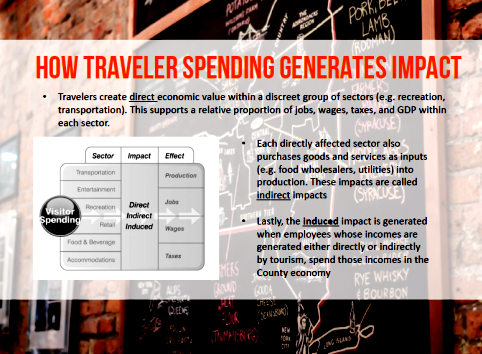
- Visitor spending touches multiple sectors, has really big impact, travelers create direct economic value
- 1 in 9 jobs in NYS is tourism, big segment and something they are looking to grow

-
Funding uses to be decided by the ownership group; this is how he would spend it and thinks it would have the biggest impact
-
Target media, need message in front of the right people to get return on investment, cost a lot of money
-
Under achieve in the sports market, bid fees very troubling; Mr. Carr was part of a sports commission in CA, will address how that could impact Syracuse
Mr. Carr:
- Sports commission would be extremely beneficially for a market like this, particularly in times of need
-
Sports commissions are a little different than when he first started, at that time they were more of a sales arm, now it is more of an event generator, have to create your own events and continue to bring them in year after year
-
Sports is an $11.4B industry, last years’ economic impact, without multipliers, averaged about $257,000 per event; room nights alone are staggering on the right kind of business and events, because of the number of facilities around CNY, particularly in the Syracuse area, could see a huge benefit from this
-
Created and worked on sports commission in Fresno, through SMG, ran it for 6 years, saw about $62M of economic impact with no multipliers and additional ROT of $2M to $3M; primarily did softball and youth wrestling, worked with NARA Institution and hosted national championships; would use sports commission to find events that fit into the War Memorial, Oncenter, and other facilities around CNY
Chairman McBride asked Mr. Carr to describe some events he had in mind. Mr. Carr responded that lacrosse would be a huge thing to go after because of the number of lacrosse fields we have. Buy-in would be needed from certain groups and institutions, and it will be very important to have people that control facilities on the board. We would chase after more high school championships, anything that will generate room nights. The key is to look at the 3-year history for any event, use formula to determine ROT and chase the event, if the ROT number is higher than the bid fee. A lot of events have bid fees, have to pay to get it here. Taking a good hard look at it before putting the funding into it is the way to remedy that.
Mr. Liedka:
-
Speed to market is everything, as it is today, if we solicit a sporting event the bid fee comes and then we comes to the legislature for approval, that process takes time, in most cases by the time there is an answer that business has signed a contract with somebody else; a sports commission would have resources and could use those funds as they see fit to bring in rooms
-
With speed to market we will be able to walk into a presentation and complete the business while there instead of waiting months, would really help us; Buffalo has one now and is very successful, had tremendous growth in youth sports, youth sports spending is at record high and continues to go up as the AAU gets more popular, especially in the Northeast, this trend will continue upward
Mr. Carr:
Mr. Liedka:
-
Major identity crisis in suburban areas, Carrier Circle and Liverpool, need to be marketed as a neighborhood, much like the City with Strathmore and Winkworth, would be able to do targeted marketing, i.e. Carrier Circle, micro target meeting planners looking for a suburban setting, market as a convention center location, plenty of meeting space, same with Liverpool, market them as neighborhoods all under one Onondaga County umbrella, gives them an identity and helps increase room nights in those markets
-
Some successful cities around the country are getting into the event business, Mr. Carr talked about sporting events, how about music and art, things that really help cities grow, i.e. Austin, TX , college town 20 years ago and now a music destination; get into event business where we create, operate and market events, create 1 or 2 events that are sustainable with nothing but growth moving forward, spike our local economy and create our own local demand, lack huge demand generators
-
Need money to close on business, being done all over the country, i.e. work for large FL resort, often compete with other big cities in FL, comes down to money, reached out to CVB for $5k to reduce room rate by $3 or $4, got an answer within 30 seconds, closed on $1M piece of business; having money for that type of thing would really help us close on more business
-
Some money could be used for infrastructure, i.e. exit I-81 to go to the Oncenter, see concrete and pavement, not sexy or appealing, business owners or people in that district could identify needs that will enhance the look, could be a beautiful Convention Center District, need trees, lighting, facade improvements and wide sidewalks, could help contribute a portion from the district to the municipality for the business owners vision to move the area forward; use of funds all on the owners, Carrier Circle Field of Dreams project pretty stagnant, 6 or 7 fields would put a lot of people in those hotels, perhaps some of the money in this district could be used for that, the sky is the limit on the use for funds, every area has their own unique need: Downtown is aesthetics, suburbs is sport venues and things of that nature
-
Need more targeted face to face meeting with customers, funds could help enhance that
-
Jumped forward on technology since coming on board, costs a lot of money, i.e. came up with Beer Trail paper passport, in 6 weeks will be able to navigate this on your phone(See photo pg. 7) , separates us from competitors, will be able to check off where you have been, check-in with your favorite beers, good social media platform to meet others that like beverages; visually build brand, started enhanced photography for website, will tease people to see what Syracuse is all about, create an emotional attachment based on photography (See photos below)
 
-
Old website photography not very appealing, wasn’t well thought-out not, newer photos very appealing, website will transform with real people doing their thing

 
-
17% of visitors time is focused on why they are here for business or meeting, 83% is not accounted for, let’s give them something to do, apps are a great way keep the spending in the county; app already started, going to a higher level, should be out next week, will be called STAMP, i.e. stamping your passport; users can check-in, if they enable text notifications and walk by a business that has enhanced messaging with VS the visitor will get a text message, i.e. Dinosaur, stop in for 10% off, able to target visitors and provide backup data as to how many people were influenced at yearend
-
Marketing efforts and social media engagement have to increase, takes people and money, the economic impact a district could provide this county is staggering, only touched the tip of the iceberg, every percent the needle moves is about 50,000 new rooms to the market, think 5%, pretty big number; other districts around the country saw a $70 return for every $1 invested in the district, very prevalent in CA, and west coast of FL, won’t necessarily reach that number here, would be happy with half, impact seen on cities par with Syracuse was $50 for every $1
Chairman McBride thanked Mr. Liedka and asked if he thought about fee verses percentage. Mr. Liedka answered that he likes the fee. The percentage could be a big number on special events and $2.00 gets us the number we need to move this area forward. Most people won’t bat an eyelash at $1.50 - $2.00, but 1% to 2% on a $450.00 room on parent’s weekend, with a 3 night minimum stay, that number can be pretty big and stands out. Directors’ of sales for area hotels have had nothing but encouragement on this because it is equitable, countywide, and they like the fact that owners have some say in how that money is spent, which can be micro targeted to the needs specific to that district. This is a really cool concept and we would be the first in NYS. Suffolk County has been considering this for some time and is trying to move forward as well.
Chairman McMahon said that he serves on the VS board and has been looking at this for some time. The model is really interesting because our ROT, as it sits today, is spread quite thin; pays for convention center, VS operating budget, arts and cultural organizations, to a degree we reimburse ourselves for facilities we help manage and other events are paid for from there. The ability to play offense is not there; paid $3.5 million to get the bowlers event, paid for when we had leftover ROT, plus surplus money. The economic impact will be $80 million. ROT will go up this year but there is not a sustainable funding source to compete for that business. This model is interesting because the owners themselves have to be on board. It is a good model that give us the ability when going for a piece of convention business to guarantee a competitive room rate, and often space needs to be discounted or free; if the County discounts free space for SMG, it comes off ROT’s bottom-line. This is another pot of money that could be used to credit SMG, or hotels, to compete for this business. This is a really good model that he thinks hotel owners will be enthused by, especially suburban hotels that don’t necessarily see the immediate impact from a lot of business, they get overflow business that can’t go to the downtown hotels.
Chairman McMahon thanked Mr. Liedka and Mr. Carr for coming over and starting the process.
Mr. Liedka reiterated that if occupancy is increased 1%, ROT alone will see an additional half-million dollars. His goal is to increase the rate and occupancy; one can see how this number would jump up. In the County’s budget process VS would be a stable number, so this really has a tremendous amount of upside. As Chairman McMahon stated, the hotel community has largely been excited about this. We are looking forward to pushing this forward, hope to have your support when the time comes, and appreciate the quorum today.
Mr. Burtis said that the goal is to improve overnight visits and questioned if we have enough rooms and how occupancy looked in the past. Mr. Liedka answered that for the 2017 market Syracuse ran 54% occupancy, 46% unoccupied. We have the rooms, well over 7,000, to get the right business that is the right fit for here. The bowlers are a great thing but those are few and far between. My job is to try and find twenty things that add up to bowlers; more realistic point of view. We will go after the big fish but want to make sure we are hitting everything in between. One thing we spend a lot of money on, and a reason why we are losing business, is transportation; must bus people from the Sheraton or Crown Plaza to the Oncenter, spending over $100,000 per year. District money could be used to pay for transportation, based on the event, that money could be a game changer.
Mr. Burtis asked if $2.00 was enough, if they had a budget, just wanted to move the needle to get it started or needed more. Mr. Liedka responded that he laid out a budget in his mind that adds up to that number, i.e. $150,000 for sports commission, $200,000 for buying business. It is a conservative number, took the occupancy rate for the year and backed out a third of the rooms that are tax exempt for government business or extended stay. The number would probably generate more, as we get more successful that number will grow.
Mr. Burtis asked if ROT money was used for some of this now. Mr. Liedka answered, “Make no mistake about it that ROT money will still be needed”; currently funded at $2,000,100 per year. Marketing efforts need to be tripled; made some gains with technology in the last 3 to 4 months, but if we want to get in front of the right people Syracuse needs to be a leader and with the resources we can get there.
Mr. Plochocki complimented Mr. Liedka noting that it is great to have someone who was on this committee for 6 years, combined with the industry background, in his position. The proof is in the pudding, these are the kinds of ideas you bring to the table, hats off to you. Not being in this industry, this concept is new to me. One of the many things I like about this is the attitude shift in how we deal with business; NYS is not the friendliest state for business. This is really involving a segment of the community, essentially saying how should we divide a portion of the public money, what would they do with it and interacting with them. This has been all too long in coming throughout the state; great to be leading the way. Mr. Liedka said thank you.
-
Introduced Kelly Fitzpatrick, no relationship to our fine DA, was an intern for VS, went to Niagara University, has hospitality background, was getting ready to take a job in Seattle; don’t want young people leaving, kept her for a reason, gave her a new role, does a lot of research
-
Research is one thing overlooked in the sales world, spent much time researching this, happy to share information on the impact for other areas par with us, tremendous amount of data could be sent via email
-
Concept was sort of in motion when he stepped in, picked it up and is comfortable, very familiar with it, represented some resorts in FL with this; has seen it transform areas, exactly what is needed here, market declining in every category possible yet inventory continues to rise, up 38% to $40% since 2013, only a couple new demand generators accompanied that, need to dig in and do our part to help move that needle
Mr. Holmquist agreed with Mr. Plochocki that this is all really great and refreshing; Mr. Liedka really knows what he is talking about, has all the background and experiences. When people travel to Syracuse many of them want to do things that are from Syracuse, not a chain. Sip on Syracuse is one example; my wife and I go to all the local breweries and some fruit pubs and the people who own these businesses are local people who are passionate about what they do. All the dollar are 100% local in the beverage industry, and we are one of the best hops growing regions in the country. Unbelievable we have been lagging in that, and just recently in a rare move by the state they are now on board. Where visitors should go when they come here is one thing that has been missing; hopes Sip on Syracuse resource is easily available in hotels and such.
-
Setup 6 priorities when taking the position, 1a) beer travel, 1b) the app; app came along faster than anticipated
-
Bringing company on board to help tell our story via pictures, real people actually out doing things – not actors; pools Instagram, Facebook, takes all those photos puts them into one thing on our webpage, i.e. someone likes craft beer, clicks on it, will see thousands of pictures, also customer reviews, all there visually
-
Visual is how we move the needle, competitors are almost there, want to step on them and move forward; logistically we are in a perfect spot to attach all the markets, hear many people that say they never knew, want them to know and are going to show it to them, will be blown away by photography, more to come, need this to push the rock over the hill
Mr. Holmquist asked how to can get Dewitt on board; read the article. Mr. Liedka said that I completely understand why he is trying to do that. The Field of Dreams is a very viable project that would definitely put heads in beds; he certainly doesn’t know what I am doing every day and vice versa. We can help him accomplish the same thing as long as the owners are on board, maybe not the same level of dollars he hopes to generate; ours is more equitable countywide. He will continue to do what he wants on his own and I respect that, I would expect he will have some sort of direction in the next few months, where this process is probably a 10 to 11 month process; met with him and offered, he’s very appreciative, realizes his is longshot, perhaps can get him to dovetail in with us. Mr. Plochocki said that because Mr. Liedka represented a large part of that area, he could truly speak to him. Mr. Liedka said that those hotels really suffer on the weekends and if they had 6 or 7 fields there it would be a home run, perfect kind of business for them. Mr. Plochocki said that Mr. Liedka has creditability in dealing with the supervisor there. Mr. Liedka reiterated that we can help him accomplish that; he is going to go his own route first and we will regroup on the other side.
Chairman McBride thanked Mr. Liedka, adding that this was a great presentation, which we got a lot out of. He looks forward to hearing more and would like the additional information. Mr. Liedka said that Ms. Fitzpatrick will email the information to each of them and thanked the committee.
A motion was made by Mr. Burtis, seconded by Mr. Plochocki to adjourn. MOTION CARRIED.
The meeting adjourned at 11:17 a.m.
Respectfully submitted,

KATHERINE M. FRENCH, Deputy Clerk
Onondaga County Legislature
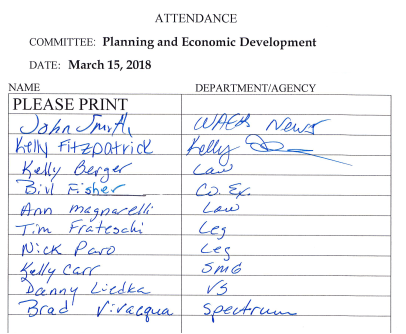
* * *
WAYS AND MEANS COMMITTEE MINUTES
March 26, 2018
Brian May, Chairman
MEMBERS PRESENT: Mr. Ryan, Mrs. Ervin, Mr. Knapp, Mr. Plochocki, Ms. Williams, Mr. Jordan
ALSO PRESENT: Chairman McMahon, Mr. Bush, Mr. Buckel, see also attached list
Chairman May called the meeting to order at 9:14 a.m.
A motion was made by Ms. Williams, seconded by Mr. Knapp, to waive the reading of the minutes of the previous committee meeting. Passed unanimously; MOTION CARRIED. A motion was made by Mrs. Ervin, seconded by Mr. Knapp, to approve the minutes of the proceedings of the previous committee. Passed unanimously; MOTION CARRIED.
Chairman May took the agenda out of order.
2. LEGISLATURE: Chairman McMahon
a. Authorizing Email Delivery of Local Laws to Members of the Onondaga County Legislature
- State allows this
- Clerk Maturo and Legislator Buckel have asked that this move forward
In answer to Mrs. Ervin, Chairman McMahon confirmed that there is no down side to doing this.
A motion was made by Mr. Knapp, seconded by Mrs. Ervin, to approve this item. Passed unanimously; MOTION CARRIED.
b. Changing the Date of the November 2018 Legislative Session
- Date change to Wednesday, November 7th
A motion was made by Mr. Knapp, seconded by Mr. Plochocki, to approve this item. Passed unanimously; MOTION CARRIED.
c. Local Law Amending the Onondaga County Charter and Administrative Code to Provide Clarification and Guidance Related to the County Legislature’s Authority to Hire Outside Counsel to Provide Legal Services, Including the Preparation of Local Laws, Ordinances, Resolutions, Legalizing Acts or Other Legislation (Sponsored by Mr. McMahon)
- Has been a lot of discussion over the last year when there is a conflict with the legislative body and county attorney’s office
- Has been a process in place with outside counsel when perceived to be a conflict, or everyone agrees there is a conflict
- Have outside counsel in budget, have a part-time legislative counsel position that has not been filled
- Local law spells out, codifies that when there is a conflict with the county attorney’s office, Chair has the ability to appoint outside counsel or internal counsel for the purpose of drafting laws and resolutions
Mr. Knapp said to clarify, the Chairman would be the arbiter when a conflict takes place. Chairman McMahon agreed; the Chair is the only logical positions –you can’t have 17 different electeds determining if there is a conflict with the county attorney’s office. It would create chaos and budgetary issues. There is a budget for outside counsel that has to be managed.
Mrs. Tarolli noted that the Law Department did not draft this and have to do some more research on it; have not really reviewed it yet. Chairman May said that with that in mind, some feedback may be expected which may result in a couple of minor changes. This has been an ongoing discussion and there is interest in something like this moving forward procedurally, he would like to at least take a vote on what was before the committee today.
Mr. Ryan asked if it would come from the counsel that the legislature assigns. Chairman McMahon said that it would. Chairman McMahon referred to Mrs. Tarolli’s comment about not drafting this, and added “of course they didn’t draft this.” He said this was drafting a law that talks about when there is a conflict, that we have our own outside counsel. He said that he is not saying there is a conflict with the county attorney’s office, but there potentially could be. The legislative body appoints outside legal counsel at the organizational session--that is who we would draw from. In answer to Mrs. Ervin, Chairman McMahon said that Mr. Frateschi is here and we have another outside firm that we can go to.
A motion was made by Mr. Jordan, seconded by Mr. Knapp, to approve this item. Passed unanimously; MOTION CARRIED.
3. FINANCE – OFFICE OF MANAGEMENT & BUDGET: Chairman McMahon
a. Transfer from Co. Gen. Undistributed Personnel Exp., Acct. 644180 Prov. for Salaries & Wages, to Co. Comptroller Acct. 641010, Reg. Empl. Salaries, $136,867 (Sponsored by Mr. McMahon)
- Budgetary transfer for the Comptroller’s office
- In the tradition of when a budget is pierced by elected officials, they come back to legislature
- Not reflected here is the Comptrollers’ office has saved in budgetary lines
- This is not the net number of what the end of the year looks like
Mr. Maturo said that he can provide the number, but it would be providing that they can appropriate the excess revenue and other available appropriations to the year-end resolution. A buy in from the CFO and the county executive would be needed. In answer to Chairman May, Mr. Maturo said that the net number is $68,000.
Mr. Morgan said that for any salary deficits, whether related to wage adjustments for contract settlements, they were budgeted in undistributed salary expense and did not budget for wage adjustments in each department. When fixing any type of negatives in the 101 account, we used provisions for salary and wage. We are being consistent, using the account used for all other departments. To make it easy and clean, this account was used to cover all of the deficits.
A motion was made by Mr. Knapp, seconded by Mr. Jordan, to approve this item. Passed unanimously; MOTION CARRIED.
4. PURCHASE:
a. Revenue Contract Report – NONE
5. LAKEVIEW AMPHITHEATER: Chairman McMahon
a. INFORMATIONAL: Naming Rights Proposal
Chairman May said that the idea today is to talk about the fact that there is a sponsorship and issues surrounding that with the details known today, until our private partner is prepared. They would go into a sponsorship to basically get promotional benefits from the investment. When they are ready to announce their engagement with the county, that is when we can get into more detail. The idea is to keep us in the loop thus far.
Chairman McMahon said that this has been an exhausting process for many people. It is here today because in order for the county to capture revenue this year, the sponsor would want their name promoted on certain things, i.e. tickets, where they get a benefit from that. The timing is very important, but we need to be fair to the private sector sponsor.
Mr. Morgan said that there is a tentative sponsorship, naming rights agreement with a major, local employer in the community. They are not prepared to disclose themselves at this point. Some of it has to do with deference to the legislature and the legislative process. The naming rights agreement was conditions upon approval of the county, including the executive and the legislature. The share to the county from the agreement would be roughly $150,000 per year for 5 years, 2018 – 2022. From that expenses would have to be netted out for signage and the types of expenses to get the sponsor’s name out there on the facilities and in other fashions. The County Executive has informed Live Nation that we are moving forward to the legislature at this time.
Chairman McMahon said that he will propose to the legislature that the money from this goes into a capital fund to basically be used for future capital needs. Each year when it comes to savings received, we put sales tax in each budget into a reserve for the debt service, in the event that our gaming revenue did not cover the bonds. A surplus account has been building up for the last few years. Essentially, the gaming revenues have exceeded the bonds, but there is nothing there for the future. At some point there will need to be improvements, i.e. the stage.
Mrs. Ervin asked if $150,000 is typical for the amount of money we would get. Mr. Morgan said the $150,000 is the county share. The promoter, Live Nation, shares in naming rights revenue with the county, so it’s actually more than $150,000/year. Some of the other naming rights agreements in place now with other county facilities are certainly more. Live Nation sells sponsorships worldwide, and will not bring to the table one that is not advantageous to them. In answer to Chairman McMahon, Mr. Antonacci said that it is $150,000 for NBT. Chairman McMahon said that is for 70 or so games. If you look at it that way, there are about 20 concerts.
Chairman May said that it is what the market will bear; it’s been out there from a discussion standpoint for four years. As a legislature, we have to balance what our instincts tell us and what the process holds.
Mr. Jordan asked if the expenses paid out of that revenues are coming out of the gross amount or is Live Nation sharing it as well. Chairman McMahon confirmed that they are. Chairman May said that he would imagine a lot of that it one-shot kinds of things. Mr. Morgan and Chairman McMahon agreed. Chairman McMahon added that there is signage on the facility and in a couple of other spots throughout.
Mr. Antonacci said that as everybody knows his office has been heavily involved in this. Assemblyman Magnarelli has a bill before the state legislature to legalize naming rights. There are some grey areas with this – not say that we shouldn’t go forward and is actually happy to hear of naming rights. Mr. Antonacci said that the big thing is the process. When his office did the naming rights audit, there was a quagmire over whether it was a donation or actually a naming right -- he would be very concerned about the process. For example, were other companies contacted and asked if they wanted to name this facility. He said he thinks it would be more of an RFP process or gauging an interest. He said that he hopes we aren’t leaving any money on the table preliminarily. As the Chairman said, this is well above what we are receiving from NBT Bank, but that is a 20 year old agreement. It’s a process in how the purchasing department goes about it--how we haven’t left a company out that may or may not have wanted to name this facility. Chairman McMahon agreed; their having knowledge of what the process has been is that there has been a sales team from Live Nation actively seeking this in addition to the County. Chairman McMahon said that he has received leads and have passed them on to be negotiated. From those efforts, you have sponsors. There are already sponsors at the facility – whether it is the lawn or the box office – continuing to market those and produce sponsors, he knows that has occurred.
Chairman May said that the reason this is here today is for the legislation that is going through; we have to make sure we have done our diligence appropriately. Part of this particular process has to do with the transference of the naming rights process through the contracts that we have in place. This is all about due diligence.
Mr. Buckel asked if a vote will be asked of the whole without disclosure. Chairman May said that “we are splitting hairs on the schedule right now, where our partner in this is sharing information on this internally still.” In answer to Mr. Buckel, Chairman May said that he can’t give a time today, but feels it’s very soon, imminent. Mr. Morgan said that he thinks it is expected that the sponsor’s name will be out there before the vote.
Mr. Buckel referred to the sharing (revenue) with Live Nation and asked if we have the contract – do we know what it provides and what it doesn’t. Mr. Morgan said that he believes the contracts were shared and available for inspection by the legislature in the past. Mr. Jordan asked if Mr. Buckel was referring to the original contract with Live Nation or the new one with the sponsor. Chairman McMahon said that the county is not entering into an agreement with the sponsor, Live Nation is. Mr. Buckel asked if there is a contract between the county and Live Nation. Mr. Morgan said “no, there is a contract between the county and SMG, and there is a contract between SMG and Live Nation.
Mr. Jordan said that we should be able to see that contract given the fact that we are sharing the revenues. Chairman McMahon said that might be an executive session detail. Mr. Morgan said that the agreement is between Live Nation and the sponsor. The agreement we have with SMG and the agreement between SMG and Live Nation gives both of those entities the ability to pursue and sell indirect sponsorships. Mr. Jordan said that the legislature has the say in whether the deal is approved or not and should be able to see the terms of that contract.
Chairman McMahon said that these are fair points, but it is also a fair point that a private sector company can’t have their contracts, that are not with the County of Onondaga, be out there for public consumption. They have to compete in the marketplace too. It most likely would be an executive session type manner. Mr. Buckel said that if it is public business, we need to know. If it private business, then that’s fine, but if it is related to public business, we still need to know.
1. TRANSPORTATION: Marty Voss, Commissioner
a. Authorizing Execution of Agreements for Gaining Access and Use of Property Owned by New York State Located Along the Western Shore of Onondaga Lake
- Items a & b related to the ongoing canalway trail extension
- No revenue impact
- Allows Onondaga Co. DOT to sign agreement with NYS to go on the property owned by NYS
A motion was made by Mr. Plochocki, seconded by Mr. Knapp, to approve this item. Passed unanimously; MOTION CARRIED.
b. Amending the 2018 County Budget to Fund in the First Instance 100 Percent of the Federal Aid Eligible Costs at a Maximum Amount of $1,512,000 for the Construction and Construction Inspection Phases of the Onondaga Lake Canalways Trail Phase I Project, Pin 3950.49, and Authorizing Execution of Agreements ($1,512,000)
- All federal aid projects are reimbursable; county fronts the money – get reimbursed by the federal government through the state
- Allows payment by the Comptroller’s office for next component of the trail from orange parking lot, down the hill and across ditch A, over to Honeywell Visitors Center
- Instructions are to get this moving ASAP and under construction this year – working with DEC, Honeywell, WEP
Mr. Knapp said that it is was discussed at length at County Facilities Committee. The typical split is 80% federal, 15% state, and 5% local. In this instance the state is not part of it; it will be 80% - 20%. The net number is $378,000. It is coming from tobacco funds. Mr. Voss said that the legislature passed a two-year resolution to take all of the tobacco, OTASC, and appropriate it for capital needs of the bridge program. Chairman May said it is not local dollars per se. Mr. Morgan said that the fund balance went up when tobacco bonds were refinanced and was appropriated to DOT’s budget. Mr. Knapp said that it is roughly $3 million. Chairman McMahon added that the funds have to be used for capital.
Mr. Jordan said that he will abstain, as he has concerns. This is talking about a very small section of the trail. It is being projected as only costing us $378,000, but that presumes that we actually get it and apply for the $1.5 million from the federal government. There are a number of projects, many of which were completed years ago, that we still have not gotten the money for. He said that we need to look at this as a project that could be costing the local taxpayers $1.89 million and not $378,000 – if and when that money comes and gets applied for.
Mr. Jordan said that in the time he has been on the legislature the county’s debt has doubled. The response to him has been been that “we are still far below our borrowing limit.” He said that we doubled the percentage of our borrowing limit that we have utilized and we are down below our fund balance requirements. He said that he does not feel comfortable moving forward with this at this time. Unless he receives information that changes his mind, he will probably be voting “no” at session. Mr. Jordan said that we are digging ourselves into a bigger and bigger hole. This is a want, not a need. This isn’t a project that has to be done – not a sewer project, and not a capital project where we have very little choice in the matter. This is something that we want to do--by no means is it something that we need to do. Chairman May agreed that it is a want versus a need.
Mr. Morgan said that we aren’t borrowing. Mr. Voss said that it is federal aid and already approved for reimbursement. Mr. Jordan said that it is even worse if we are using liquid funds that we have available to front the money. Mr. Morgan said “don’t bring the debt issue into it because it’s not relevant in this case.” He said that we are not borrowing money. Mr. Jordan said that we could be looking at a $1.8 million project, not a $379,000 project. He said that we are way below our 10% fund balance requirement.
Mr. Plochocki agreed with Mr. Jordan that we obviously want something done at the least expense. “If there is criticism of the cost of this and it could specifically be brought down, I am all ears for that.” He said to keep in mind that these things, by the bare nature of them, are very, very expensive. When talking about the debt load doubling, that is true, but the main reason it has doubled in the past few years is because we are mandated by the federal court system to invest over $400 million into the Onondaga Lake project. It wasn’t our choice. Mr. Plochocki said “our debt load is the nature of the beast.” Technically speaking, the trail is an elected project and does not dispute that. He said that one of the reasons he has been very involved in this and pushing it since the very beginning, is that because the taxpayers have been forced to spend over $400 million cleaning up the lake, it would be nice for the taxpayers to be able to enjoy the lake to the extent that they can. Surveys after surveys have been done, and the number one thing people have said and continue to say is that they want more trail access to the shore of the lake. In general, he does not want to see the building of trails all around for no reason; this is a special case, where the taxpayers deserve access to this lake that they have been forced to spend so much money on. If there are specific criticisms, i.e. steel costing too much, he would like to hear them. The bigger picture is that this isn’t just building a trail for pure elective reasons anywhere. There is a reason – it is driven by taxpayer popularity. “It is, perhaps, the most popular thing that we are doing.”
Chairman McMahon said that everybody should be cost conscious of everything we vote on. At the same time, this is not something new. This is the Loop the Lake Trail; we have voted on extension far past this one. All we are doing now is appropriating funds, which the Tobacco refinanced bonds have to go to capital. The debate should be “should it go to other capital?” That is our cash; we have a federal grant; this actually is putting bricks and mortar in the next part of the extension. Honeywell will be responsible from the Visitors Center, helping us get all the way through Roth Steel and connecting to the Creek Walk. Millions of dollars have already been spent on all of this. It is clearly the most popular thing we have done. There will be other votes where we could try to derail the Loop the Lake Trail; that’s our prerogative. This is actually a phase where we got funds from the tobacco money and we have federal reimbursed bunds. “This is an easy one.”
Mr. Jordan said “I couldn’t disagree more; we are Ways & Means; we are looking at dollars and cents.” Regardless of whether it is the most popular project or not, we are well below our fund balance requirement. We are spending additional monies, cash, to fund this project. Our fiscal stress level has gone up considerably in the last couple of years. It would be a whole different ballgame if we had millions of dollars above our 10% fund balance requirement, but we don’t. We are millions of dollars below our fund balance requirement. Now we are talking about using more cash to fund a project, which doesn’t have to done now. He said that he is not saying don’t ever do it; what he is saying is that maybe we are not in a financial position right now to be doing this project.
Mr. Jordan said that we have necessary projects that continue to come up and we keep spending money on things that are wants and not needs. If we were in a better financial position concerning cash to do this, it would be a whole different ball game, but we are not.
Chairman McMahon referred to Mr. Jordan’s comment that we are well below fund balance and asked what our fund balance – is it 9.4% or 9.9%”. Mr. Morgan said that the year hasn’t closed, but agreed that is roughly in that range. Mr. Maturo said it will be down to 8.5%. Mr. Morgan said “the books aren’t closed, so I don’t know how he’s coming up with that number.”
Chairman McMahon said that the debate right now is that this will somehow impact our fund balance. The Tobacco money has restrictions on what it can be used for. Mr. Morgan said that it has to be approved by the bond counsel and can only be used for capital expenses. We already have a plan that is approved, which includes this expense. “If we don’t use it for this, it will sit there and not be used.” Mr. Jordan asked if there was no other capital expense this could be used for. Mr. Morgan said that it has been approved already. He said “it has been approved; at this point in time you can’t adjust it.” Mr. Jordan asked if we can go back and ask for approval on a different capital project. Mr. Morgan replied, “I don’t believe so.” Mr. Jordan asked to be provided with a legal opinion on that. He said that he finds it hard to believe that bond counsel is only going to approve this money to pave a half of mile of Loop the Lake Trail and would not consider an alternative use for a capital project. He said that is incredulous to him. It’s what has been approved now, but it doesn’t mean it’s the only thing that they will approve.
Mr. Ryan said that even if we could, would we want to as we have invested in the Loop the Lake Trail and this is just another piece. “We have appropriated the money; we are going to spend the money; let’s do it.” He said he would be willing to hear more about the 8.5% vs. the 9.4%, but this doesn’t have anything to do with fund balance.
Mr. Jordan said that there are a number of capital projects that we went to court with and don’t have any choice with. He questioned why we are spending money on things that we don’t need right now, when we know there are capital projects coming up that we are going to have to do. It is all one big pot. To view it as one element does not affect another element, is not the case. He said that he thinks Wall Street agrees with us – we are showing our fiscal stress level going up, not going down. Mr. Morgan said that Wall Street doesn’t give us our fiscal stress level.
Chairman May said that this was reviewed in County Facilities Committee with a unanimous vote. Mr. Voss added that the appropriation has already been done.
Mr. Knapp asked what the status of the federal portion of this is. Mr. Voss confirmed that this is approved. Mr. Knapp said that there is no question of applying for it and getting denied. Mr. Rauber said that it is in the Transportation Improvement plan; the money is sitting there waiting to be used. Once this resolution passes, they will execute an agreement with NYS to essentially begin the reimbursement. Mr. Jordan said “as long as we apply for the money and we don’t have a perfect record of that right now. Chairman May asked “how often does that really happen.” He asked that if we bond for $10 million, what percentage of those $10 million aren’t recovered through federal support. (Inaudible comments from Mr. Morgan, while Mr. Voss was speaking.) Mr. Voss stated that he hasn’t seen an instance from a project that he has been involved in that was approved and not paid. Mr. Jordan said that he has seen a list of projects that have been completed for years, which we haven’t asked for the money for.
Mr. Maturo said that he can go through all the capital projects, as they go through them at year end. He said “we have some significant balances out there that are to receive state and federal aid that we haven’t applied for yet.” He said that there are also projects out there approved for bonds that haven’t been borrowed yet. Chairman May asked to be provided with some information on this.
Mr. Morgan said that Mr. Maturo was disingenuous – we front money for capital projects. Mr. Maturo provided an example that there are two Van Duyn projects from 2014 that have $1,000,000 dollar deficit which are funded by serial bonds. He questioned when that will be borrowed. He said that is from 2014, and Van Duyn is dead and gone.
Chairman May said that we have reached some tangential points that we need some clarification on. He doesn’t think anyone in this room doesn’t want to know more about them.
A motion was made by Ms. Williams, seconded by Mr. Plochocki, to approve this item. AYES: 6 (May, Knapp, Plochocki, Ryan, Williams, Ervin); NOES: 0; ABSTENTIONS: 1 (Jordan). MOTION CARRIED.
6. LAW: Lori Tarolli, First Chief Deputy County Attorney
a. Amending the 2017 County Budget Make Available Funds to Support Retained Counsel ($40,000) (Sponsored by Mrs. Ervin, Ms. Williams)
- Transfer $40,000 for for the Dixie lawsuit
- To pay 2017 bills so 2017 account won’t be in the negative
- In July 2017 asked for $75k – thought it would carry through 2017, but missed the mark on it
In answer to Mrs. Ervin, Mrs. Tarolli said that it is to pay the bills for the law firm that has been retained to defend the Comptroller. In answer to Mr. Knapp, Mrs. Tarolli confirmed that we are defending ourselves for our portion of it.
Chairman McMahon asked if there money earmarked for this litigation in the County Attorney’s 2018 budget for this litigation or will this come back to us. Mrs. Tarolli said that this will come back; money is not earmarked for this in 2018. Chairman May said, for point of clarification, we don’t budget for unknown expenses. If we need outside counsel, we retain it and pay for it as needed. He said that as it understands the budget process, a bunch of money is not put into an account in the event the county has to defend itself and not use it. Mrs. Tarolli said “not typically.”
Mr. Buckel referred to his prior experience on the legislature and noted that with this type of resolution, a number was simply put in on a line. He understands that in the 2017 budget there was roughly $515,000 appropriated for professional services. Those are typically outside counsel fees that were incurred by the county to defend or indemnify. He also understands that you are trying to close out the books for 2017; this is needed because the amount spent exceeded the line budgeted. Mrs. Tarolli agreed, noting that they blew their budget. Mr. Buckel said that it is also true that this wasn’t the only matter in which the county was incurring outside counsel fees. Mrs. Tarolli agreed.
Mr. Buckel said that he likes where the sponsors of this legislation are headed, as it was always swept under the rug, didn’t want to know, and kept it secret what these matters were. Disclosure is important. Several legislators on another matter concerning OCC are suggesting that we need full disclosure. He said that he would like to see, before being voted on at session, the list of where we are spending our money, how much we paid on each, and how much in total. That way we can have a fair presentation on all of the debt, as opposed to cherry picking one or none as we used to do.
Mrs. Tarolli said that the distinction is that this if for 2017 bills. The budget for 2017 was adopted in October and we didn’t retain this counsel until October 18th, so it was not something that they budgeted for. “The defense for someone of this extent, this magnitude, was not within our budget.” Mr. Buckel said that each year we budget based on the anticipated. He said that in terms of public disclosure, we shouldn’t just say it is one – let’s look at all and have the legislature see what we are spending money on for outside counsel fees, instead of cherry picking just one. Mrs. Tarolli said that an estimate was put together for their adopted 2018 budget. Mr. Buckel said that we don’t know what it was spent on in 2017, and it may be useful for us to see so that we can have a fair consideration, and the public will have a fair, open book of what is going on around here.
Mr. Jordan said that he believes Mr. Buckel’s point is that we set aside so much money for outside counsel, we set aside so much for this case or that case. To say that somehow this is limited to this case is a misrepresentation in sense because we are exceeding out budget for professional services.
Chairman May said that there were a lot of talks and ideals on how this particular bill should get approved and paid. He said that here we are on March 26th, in his mind, as one person, this is just a fiscal matter that we’ve got to pay a bill. The merits of the process and the questions are good, but today he wants to focus on getting the bills paid and not having the legislature be a bottleneck for closing our books from 2017.
Mr. Antonacci said that he hates to see this committee get coapted by the County Executive’s office. “We all know this is dirty, rotten, politics. Mr. Antonacci provided a couple of examples – asking Mrs. Tarolli when the district attorney’s bill was paid recently for $40,000 for the Pataki lawsuit, did a separate resolution come over here with his name on a resolution. “The answer is “no, we didn’t.” He said that last year when we had a $250,000 transfer for the pay raise lawsuit, when the county decided to not use the Law Department and went out and hired outside counsel, did we have that name on the lawsuit?. He said that the answer is “no; you guys are being used.”
Mrs. Ervin asked if this is the same resolution that we had in July. Mrs. Tarolli confirmed that it is. Mrs. Ervin said that is just paying the bill – we did it in July; we are doing it now.
A motion was made by Mrs. Ervin, seconded by Ms. Williams, to approve this item. Passed unanimously; MOTION CARRIED.
b. Settlement of Claim
A motion was made by Mr. Jordan to enter into executive session for the purpose of discussing a settlement of claim in the the case of Jane Doe vs. Onondaga County Department of Social Services, seconded by Mr. Knapp. Passed unanimously; MOTION CARRIED.
Following executive session, the Clerk was informed that an amended motion was made to enter into executive session by Mr. Jordan, seconded by Mr. Knapp, to discuss JANE DOE, (Jane Doe being a factitious name intended to protect plaintiff’s anonymity with regard to an action that includes allegations of sexual abuse as a minor) vs. Onondaga County, Onondaga County Department of Social Services, Joseph Sanfilippo and Jennifer Sanfilippo.
and
V.W, a minor, by and through his parent and, natural guardian DERECK WILLIAMS; R.C., a minor, by and through his parent and natural guardian, SANDRA CHAMBERS; C.I., a minor, by and through his parent and natural guardian VERTELL PENDARVIS; M.R., a minor, by and through his parent and natural guardian KAREN RAYMOND; F.K., a minor, by and through his parent and natural guardian KASHINDE KABAGWIRA; and J.P, a minor, by and through his parent and natural guardian ALISSA QUINONES; on behalf of themselves and all other similarly situated, -vs- EUGENE CONWAY, Onondaga County Sheriff, in his official capacity, ESTEBAN GONZALEZ, Chief Custody Deputy of the Onondaga County Justice Center, in his Official capacity; KEVIN M. BRISSON, Assistant Chief Custody Deputy, in his Official capacity; and SYRACUSE CITY SCHOOL DISTRICT
A motion as made by Mr. Knapp, seconded by Ms. Williams, to exit executive session and enter regular session. Passed unanimously; MOTION CARRIED.
Chairman May stated for the record that no action was taken during executive session.
A resolution was presented entitled “Authorizing the Settlement of the Action Filed with the Supreme Court of the State of New York, County of Onondaga, Jan Doe V. Onondaga County, Et. Al. A motion was made by Mrs. Ervin, seconded by Ms. Williams, to approve the resolution. Passed unanimously; MOTION CARRIED.
Chairman May referred to committee protocol noting that committee members are recognized first, followed by other legislators, and then guests. He stated that this is the fiscal policy making committee of the Onondaga County Legislature. He said that we are making business decisions and are going to need to get into political things every now and then. It should never be personal.
A motion was made by Mr. Knapp, seconded by Ms. Williams to adjourn. Passed unanimously; MOTION CARRIED.
The meeting was adjourned at 10:30 a.m.
Respectfully submitted,

DEBORAH L. MATURO, Clerk
Onondaga County Legislature
|


















































